 Royal Navy (1930-34)
Royal Navy (1930-34)G class: Gallant, Garland, Gipsy, Glowworm, Grafton, Grenade, Grenville*, Greyhound, Griffin
H class: Hardy, Hasty, Havock, Hereward, Hero, Hostile, Hotspur, Hunter, Hyperion
Havant class: Harvester, Havant, Havelock, Hesperus, Highlander, Hurricane
WW2 British Destroyers:
V class | W class | W mod class | Shakespeare class (1917) | Scott class (1818) | A/B class (1926) | C/D class (1931) | E/F class (1933) | G/H class (1935) | I class (1936) | Tribal class (1937) | J/K/N class (1938) | L/M class (1940) | Hunt class DE (1939) | O/P class (1942) | Q/R class (1942) | S/T/U/V/W class (1942) | Z/ca class (1943) | Ch/Co/Cr class (1944) | Battle class (1945) | Weapon class (1945)Hunt Type I class DE (1939) | Hunt Type I class DE (1939) | Hunt Type I class DE (1939) | Hunt Type I class DE (1939) | Captain class DE (1941)
The G- and H-class were 18 British Royal Navy destroyers built from 1934 (24 by adding the 6 supplementary Brazilian ships, all requisitioned in 1939 as the Havant class). They were also a major export success, being built also for Argentina and the Royal Hellenic Navy. They were ordered in the 1933 and 1934 naval program as follow-up of the F class, but with more compact internal arrangement without their cruising turbines, more range and less displacement. Thye also were all fitted with SONAR and were armed like the previous destroyers, with two purpose built flotilla leaders, USM Greenville and Hardy. The Havant class for Brazil were also different. Their first missions were in the Mediterranean (Non-Intervention Agreement, Spanish Civil War 1936–1939). They pair a heavy price in wartime and most were sunk in action to various causes, some as early as 1940.
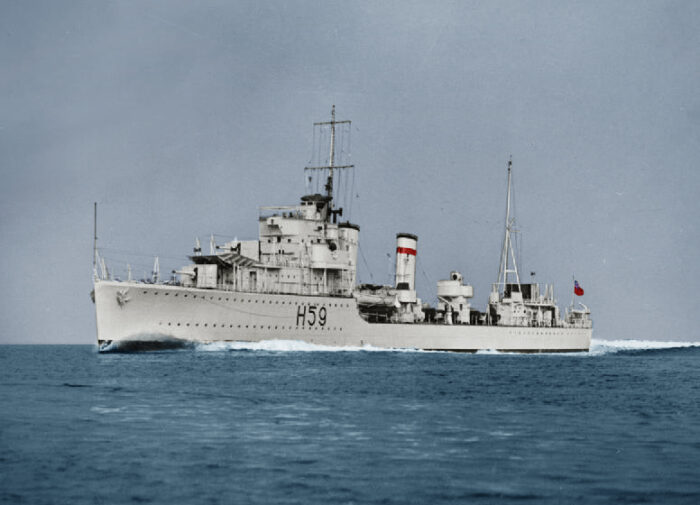
HMS Gallant (H59) underway prior to the war
The G and H class destroyers:
Design Genesis
The G class were ordered as part of the 1933 Naval Construction Programme. The H class followed the same program for 1934. They were heavily based on the preceding F class, with only monir changes. The greater improvement was to make them lighter (and thus regain speed and performances overall) by eliminating their heavy cruising turbines, instead relying on a more efficient two-stage (HP, LP) steam turbine. This more compact machinery helped reducing dimensions and sparing useful displacement. This could be exploited for later AA additions, however few reached 1943.
The H class were essentually repeats of the G class, with only minor differences such as their new gun mount capable of 40°. Due to this all authors placed them in the same group, and sometimes with the I class as well (like Conways), but the latter had more differences and for the sake of keeping this article short enough, they will be seen separately. All these destroyers were fitted with ASDIC as well as the Two-Speed Destroyer Sweep (TSDS) minesweeping gear to perform that task as well. Now a constant feature of RN destroyers, this spared the fleet to man new dedicated minesweepers and only concentrate on a few Minelayers. They confirmed a long-held design trend that will end with the “tribals” launched from 1937. After this, the wartime J,K,N classes were a breed apart, a complete new start.
Operations
The G and H class were among the most impacted by the intensity of early operations with 17 of both class (not counting the Brazilians) sunk in action, many in 1940. With the war looming on the horizon, they were recalled home, or were sent to the North Atlantic, from October to November 1939. They acted as convoy edcorts and ASW patrol ships with two lost to German mines, three in the Norwegian Campaign, one by a German cruiser, two at the the First Battle of Narvik, three more in the evacuation of Dunkirk. Survivors of the G class were sent to the Mediterranean in May 1940 with Griffin and Greyhound taking part in the Battle of Dakar. In subsequent battles with the Regia Marine, two were lost, but they claimed two Italian submarines. They spent the remainder of their career in the North Atlantic on convoy escort duties with more lost ot U-Boats, German submarines, sinking six in exchange.
The H class took part in many high profile engagements, such as the Malta convoys, Battle of Cape Matapan, evacuation of troops from Greece and Crete. Three of the H class were at the Second Battle of Sirte and at Operation Vigorous in June. In late 1942 and 1943 survivors were converted as escort destroyers, transferred to the Royal Canadian Navy (RCN) while under conversion and the remainder joined the Havant class on escort duty, North Atlantic. On took part in the Italian compaign anoter to Operation Overlord. They also claimed six U-Boats and were broken up or sold off postwar (Netherlands, Dminical Rep.).
Design of the class
The G were ordered through the 1933 Naval Construction Programme. The H class following in 1934. They were heavily based on the preceding F class, but the elimination of cruising turbines and development of more compact machinery allowed their dimensions and displacement to be slightly reduced, gaining a bit in performance, range and having more roop for upgrades. Also, the “G” class differed from the “Е” class by their tripod mainmast. The H class repeated the G class design, but with some minor differences, such as their new 40° angle main gun mounting. They were all fitted with ASDIC-sonar and the Two-Speed Destroyer Sweep (TSDS) minesweeping gear, enabling minesweeping capabilities. In 1940, thus, the RN had with its destroyers a sizeable number of fast minesweepers, a category that was lacking in speciality.
Hull and general design
The G class were slightly smaller than the F class, displacing 1,340–1,350 long tons (1,360–1,370 t) at standard load (vs. 1,405 long tons) and 1,854–1,860 long tons (1,884–1,890 t) at deep load (vs. 1,940 long tons). This was thus c50 tons less. The overall length was reduced as well at 323 feet (98.5 m) (vs. 329 ft (100.3 m)) for a reduced beam of 33 feet (10.1 m) vs.33 ft 3 in (10.13 m) but similar draught of 12 feet 6 inches (3.8 m). Externally they resembled the F class, in all details. The squared bridge for example, forecastle proportions, placement of the main artillery, torpedo tubes, etc. To dive deeper in these layout details, see the previous E-F class.
Peacetime complement was 137 officers and ratings but this increased to increase to 146 in wartime. Despite their smaller scale meaning they had potentiually some addition margin, this was not the case. They had their stability limit as built as communicated by the Director of Naval Construction given their reduced beam compared to the lenght. He believed they already were close to their top weight limited and needed to be lightened or ballasted for more additons.
Powerplant
No critical change was made here apart the omission of cruising turbines, making the whole machinery more compact and lighter. They were powered by the same two Parsons geared steam turbines as before, driving a propeller shaft. Steam came from three Admiralty 3-drum boilers operating at a pressure of 300 psi (2,068 kPa; 21 kgf/cm2) and temperature of 620 °F (327 °C). HMS Hyperion tested a Johnson boiler. The turbines were rated for 34,000 shaft horsepower (25,000 kW) total (versus 36,000 shp (27,000 kW) on the F class) for a top speed of 35.5 knots (65.7 km/h; 40.9 mph) same as for the F class. They also carried between 450 and 475 long tons (457–483 t) of fuel oil for a range of 5,500 nautical miles (10,200 km; 6,300 mi) at 15 knots (28 km/h; 17 mph) versus 6,350 nmi (11,760 km; 7,310 mi) for the F class.
Armament
They also kept the same main armament as the E-F classes, with four quick-firing (QF) 4.7-inch (120 mm) Mark IX guns in single mounts, superfiring pairs ‘A’, ‘B’ and ‘X’, ‘Y’. The main change here was their reworked mount for a maximum elevation of 40°, by modifications of the mount itself. The G class did the same as the F class, with the removal of the elevation lock, thanks to a lowered section of the deck around the mount. This “well” allowed the breech to be lowered below deck height. On the H class, it was decided to eliminate the wells, seen as rust traps, but the gun mount were modified in detail to reach the same elevation. HMS Hereward was a testbed for the twin 4.7-inch gun mount later adopted for the Tribal as well as following the J, K and N classes. It was fitted forward instead of the superfiring ‘B’ mount.
The anti-aircraft (AA) defence comprised two quadruple mounts for QF 0.5-inch Vickers Mk III machine guns, on platforms between funnels like for the previous F class. They also inherited the same two quadruple torpedo tubes mounts as the previous F class. HMS Glowworm however tested a new quintuple mount later adopted also on the J-K-N. For ASW work they had two depht charge throwers, one rack aft for 20 depth charges total.
BL 4.7 inches/45 Mark IX
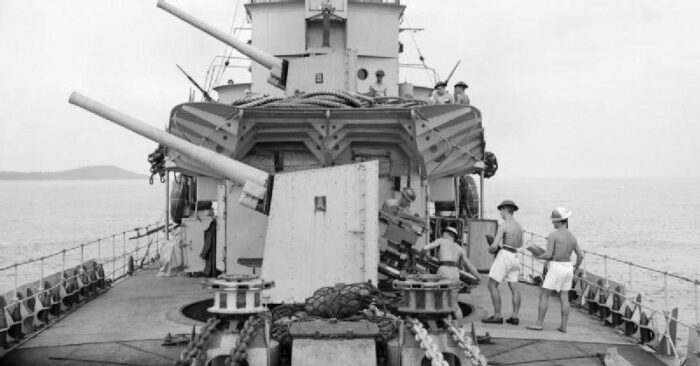
Main guns tested at 30°+ elevation on HMS Foxhound (IWM)
Produced from 1928, just as these classes were launched, the QF 4.7-inch Mk IX remained in service until 1970 and was used or exported to the RCN, RAN, Royal Hellenic Navy, Royal Netherlands Navy, Polish Navy, Royal Norwegian Navy, Turkish Navy, Dominican Navy, Argentine Navy, and Brazilian Navy with 742 Mk IX produced and 372 Mk XII of an improved design. Instead of CP Mk.VI** mountings, max elevation 30° on the E-F class new mounts were introduced, the Mark CPXVIII mounting with a ring in a deck railing base of more than 2m in diameter, 0.35 m deep. It was covered by special metallic boards lifted at higher elevation angles, ensuring the gun recoil remained its natural balance and avoiding the risk of blowing the breech into the deck. This construction however was rciticized afterwards, because of its impracticality, albeit it was used on all single gun destroyers up to G class. Later the mounting evolved into the CPXXII with a spring operated rammer.
The maximum elevation of 40° was achieved by “wells”n lowered section of the deck around the mount on the G class. But they were criticized and on the H class, new mounts were fitted instead. These guns fired a 50-pound (22.7 kg) shell at 2,650 ft/s (810 m/s) but the range of 16,970 yards (15,520 m) was rarely reached, or at least with any accuracy.
Specifications Mark IX**
Mass: 2.984 long tons (3,032 kg)
Length: 220.62 in (5.60 m) Barrel 212.58 in (5.40 m) L/45
Shell: Separate loading cased charge, 50 pds (22.7 kg) SAP/HE
Breech: Semi-automatic horizontal sliding-block, Hydro-pneumatic recoil
Perfs: 15 rounds per minute at 2,650 ft/s (810 m/s) to 16,970 yards (15,520 m) at 40°
The Mk XVII main gun mounts of the H class had natural gun balancing, and secured their 40° elevation angle at the expense of shear of an axis of trunnions of a gun to a gate, allowed more space for recoil at maximum elevation angle.
QF 0.5-inch Vickers Mk III
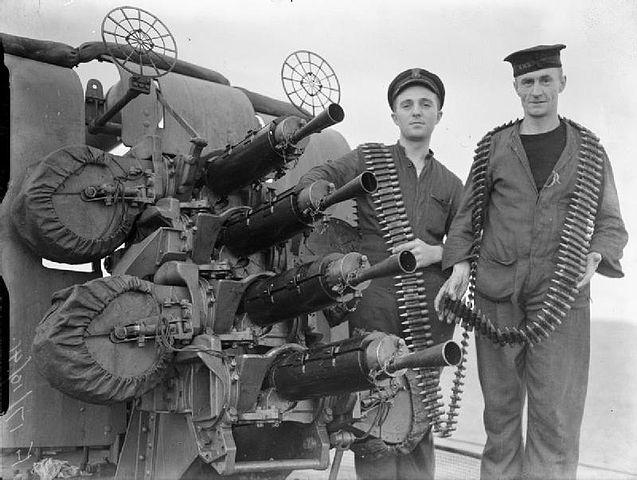
Two quadruple mounts for the QF 0.5-inch Vickers Mk III machine gun on platforms between the funnels, one mount either side. They were poorly protected against strafing fire and of limited range, only having to offer a good volume of fire at close range. Between these and the limitations of the main guns, there was a critical inter-range gap remaind uncovered, and this was paid dearly in WW2 albeit additions were made (see below).
The Mark III was a navalized land version in mountings of four tandem guns here, installed on the wings from 1931. This mount proved insufficiently powerful at short-range but from 1940-41 they were replaced on a per-mount basis by Oerlikon 20 mm cannon. This mount used a 200-round magazine per barrel wrapping the ammunition belt around the magazine drum. 700 rpm (cyclic) or 450 for longer periods. The barrels could be setup for a spread 60 ft (18 m) wid, 50 ft (15 m) high at 1,000 yd (910 m). Vickers claimed 800 rounds in 20 seconds, reload in 30 seconds.
QF 0.5-inch specs
63 pounds (29 kg), excluding 10 pounds (4.5 kg) cooling water, 52.4 in (1.33 m) long, barrel 31 in (0.79 m)
Cartridge 12.7×81mm 0.5 inches (12.7 mm) mv 2,540 feet per second (770 m/s) ceiling 9,500 feet (2,900 m range 4,265 yards (3,900 m)
21-inches torpedo tubes
The greater change was going from triple to quadruple torpedo tubes banks on the C-Ds and this was repeated of course with the E-F. This really set apart these interwar British destroyers and imposed a new standard. They were placed on a deck top plaform, reloadable thanks to cranes. Later in wartime due to additions of AA and ASW, the aft bank, then then layer the amidship one were removed on most ships to make room and spare weight. The torpedoes were rarely used in long range mode, they were just too slow. The 40 knots mode obliged the ships to close the target to less than 5,000 yards to be of any use. So the early 1918 model was quickly superseded, but here are its stats anyway:
Specs 21 inches Mark V (1918)
Weight: 3,828 lbs. (1,736 kg)
Length: 23 ft 3 in (7.086 m)
Explosive Charge: Unknown, c600 Ibs. or 250 kgs TNT
Range and Speed settings: 5,000 yards (4,570 m)/40 knots or 13,500 yards (12,340 m)/25 knots
Power: Wet-heater
Mark VIII* (1930)
Weight: 3,452 lbs. (1,566 kg). neg. buoy. 804 lbs. (365 kg)
Length: 21 ft 7 in (6.579 m)
Explosive Charge: 805 lbs. (365 kg) Torpex (late VIII*)
Range and Speed settings: 5,000 yards (4,570 m)/45.5 kts or 7,000 yards (6,400 m)/41 ks
Power: Burner-cycle, 322 hp @ 45 knots
Mark IX** (1935)
Weight: 3,732 lbs. (1,693 kg). Neg. buoy. 732 lbs. (332 kg)
Length: 23 ft 10.5 in (7.277 m)
Explosive Charge: 805 lbs. (365 kg) Torpex
Range and Speed settings: 11,000 yards (10,050 m)/41 kts, 15,000 yards (13,700 m)/35 kts
Power: Burner-cycle, 264 hp @ 41 knots
The Mark X was introduced in late 1940 and perhaps installed, it was capable of 47 knots thanks to a wet-heater.
Hedgehog
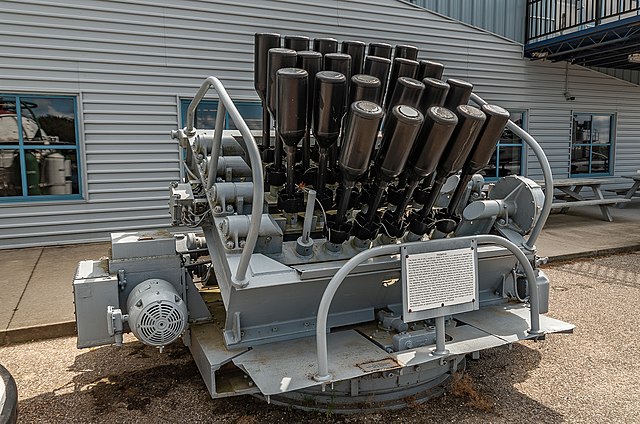
Most received in 1942 instead of their”A” position main gun forward a 24 tubes 178mm Hedgehog ASWRL. There was suspended platform woth location for 24 launcher spigots firing a 65 lb (29 kg) 7 in (178 mm) rocket carrying 30 lb (14 kg) TNT or 35 lb (16 kg) Torpex to 200–259 m (656–850 ft) and explosing by contact. They created a circle like pattern on the suspected contact, leaving little change of survival especially to a just submerged U-Boat. The charges were too small to crack open a hull but at least they could create leaks and oil slicks that could be a position giveaway.
Depth Charges
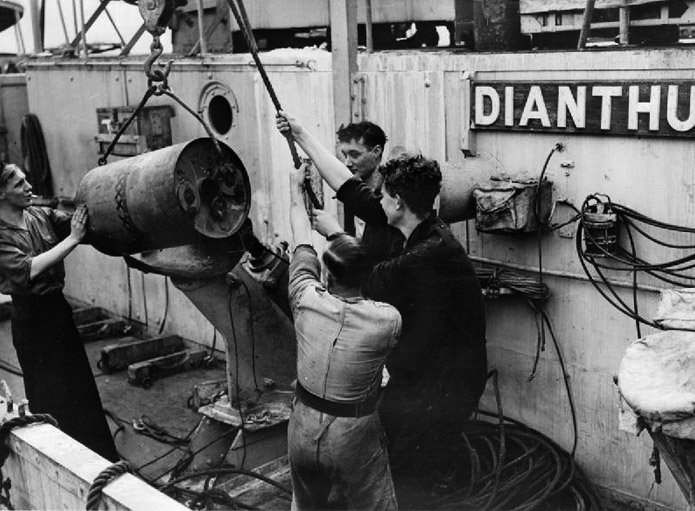
Mark VII depth charge thrower being reloaded.
The usual set comprised two Mark II Depth Charges Throwers (DCT) aft on the poop deck, facing either side, and a single Depth Charge Rack (DCR) with 20 DCs at the stern. Theere were railing to the aft superstructure for a total storage of 40 more DCs. Reload was made by hand, using winches, always a dangerous task with a rolling deck washed by waves. These depth charges were of the standard British type, meaning it was the Mark VII: In entered service in 1939, weighted 420 lbs. (191 kg) and carried a 290 lbs. (132 kg) TNT with a sink Rate or Terminal Velocity of 9.9 fps (3.0 mps) with a max setting at 300 feet (91 m) later 500 feet (182 m).
Its possible they were later upgraded to the the Mark X (1944) and the Mark X*. The X** was not introduced in service in 1945 despite its great depth (down to 1,500 feet (457 m)). Squid and Hedgehog made them obsolete. There are doubts also if the Mark VII Heavy studied from 1940 and proper to depth charge launchers were used aboard, outside experimentally. Weighting 420 lbs. (191 kg) with a 290 lbs. (130 kg) TNT charge, they had a sink rate/terminal velocity of 16.8 fps (5.1 mps) and a 300 feet (91 m) max setting, helped with a 150 lbs. (68 kg) cast-iron weight attached. The idea was to reach the U-Boat faster, and it was claimed it could split open a 0.875 inch (22 mm) hull at 20 feet (6.1 m), or force to surface at 12 m or more. The game changer was a minol charge (1942) for better results, with a 30% increase.
Mines
Not all E/F class destroyers were converted, only two of the E class at experimental level. At their stern they received a pair of sponsons housing part of a mechanical chain-conveyor system to ensure smooth delivery of the mines, stored on railed on the weather deck. To compensate for the weight of thrse Mark XIV mines, the two aft 4.7-inch guns and associated ammunition and even the two sets of torpedo tubes even the whalers and davits were removed.
Mark XIV mines:
These were a 1920s design with either a 320 lbs. (145 kg) or 500 lbs. (227 kg) charge, and Hertz horns. Switch horns were installed and they became the Mark XVII.
Sensors
Sonars
Type 119 ASDIC: 1930 hydrophone type.
Type 124: From 1937, improved Type 121, range 2500 yards, 1st with chemical range recorder.
Type 127: From 1940, mostly installed on British Flower class sloops, first with a bearing plotter.
Type 144: From 1943, range 2500 yards (2300 meters) to 3000 yards (2700 meters), integrated into the fire control and coupled with Hedgehog. 1st with bearing recorder, automatic scanning, turning 5 degrees after each ping, often coupled with the Type 147 “Sword” depth finding sonar with a beam steerable vertically. Also coupled with the Q attachment reducing the under hull blind spot. 60° deep vertical beam, trained with the main Type 144 transducer.
When purchased by Canada, the four C-class destroyers were refitted on Canadian specifications and saw the Type 124 ASDIC installed, and steam heating probably fitted.
Radars
Type 286: Naval air search radar, first destroyer set, very crude, not rotating. Full data 286P: rotating antenna, better bearing accuracy of 3-5 degrees.
This was a metric target indication set, based upon RAF ASV Mark II set. The Type 286M had fixed antennas (central Tx and sides Rx) to indicate contact bearing. Fixed antenna so the entire ship needed to be aimed in the right scaning angle. The Type 286PQ had a steerable combined Tx/Rx antenna from the Type 291 set at least.
Type 271: Corvette small surface search radar using a standard microwave-frequency system with improved resolution to spot surfaced U-boat 3 miles (4.8 km) around, or a periscope at 900 yards (820 m). Full data
Type 285: Anti-aircraft gunnery radar available from late 1940, Frq 600 MHz, power 25 kw, range 18,000 yd (16,000 m), ceiling 15,000 ft (4,600 m) accuracy 150 yd (140 m).
Fire Control
The main guns were controlled by the Admiralty Fire Control Clock Mk I.
Its data came from the manually-operated director-control tower plus separate rangefinder above the bridge. They could not be use for anti-aircraft fire, which was aimed by eye. HMS Hero and Hereward were given a new bridge that soon became standard up to the Battle class of 1944. For Hereward this was due to the tests of her new, massive twin-gun mounting as its trunnion height 13 inches (33 cm) was much higher, forcing to raise the wheelhouse for the helmsman to see over its top and thus it was placed in front of the bridge, no longer underneath, and with angled sides for a wedge shape with sloping roof. But this was the exception, the remainder destroyers kept their caracteristic squared bridge with the main fire control telemeter behind.
⚙ G/H class specifications |
|
| Displacement | 1,340–1,350 long tons standard, 1,854–1,860 long tons FL |
| Dimensions | 323 x 33 x 12 ft 6 in (98.5 x 10.1 x 3.8 m) |
| Propulsion | 2 shafts GST, 3 Admiralty 3-drum boilers 34,000 shp (25,000 kW) |
| Speed | 35.5 knots (65.7 km/h; 40.9 mph) |
| Range | 5,530 nmi (10,240 km; 6,360 mi) at 15 knots (28 km/h; 17 mph) |
| Armament | 4× 4.7 in, 2×4 0.5 in AA, 2×4 21 in TTs, 1x DCR, 2× DCT, 20 DCs |
| Sensors | ASDIC, see notes wartime additions |
| Crew | 137 (peacetime), 146 (wartime) |
Armament Changes
In 1940, HMS Garland, Greyhound, Griffin, Grafton and Grenade, as well as Hasty, Havock, Hereward, Hero, Hostile, Hotspur, Hyperion had one torpedo tubes banks removed and replaced by a single 3-in(76mm)/45 QF Mk I/II/III/IV AA gun. in 1941, Garland, Griffin saw the removal of the forward B main gun for two 20mm/70 Oerlikon Mk II/IV and depth charges increased to 70.
In 1941 also, HMS Hasty, Havock, Hereward, Hero, Hotspur, and Gallant, Greyhound, Hyperion saw the addition of two more Oerlikon AA guns.
In 1941-1942 survivorts obtained the type 271 and type 286/P radars. In 1942-1943, HMS Garland, Griffin, Hasty, Havock, Hero, Hotspur, sw the removal of their quad Vickers 0.5 in AA for two more 20mm/70 Oerlikon AA guns Mk II/IV.
In 1943 HMS Hero and Hotspur saw the removal of B main gun and its type 124 sonar for a forward 24x 178mm Hedgehog ASWRL as well as up to 125 DC (4 DCLs) and the new type 144 sonar. Garland and Griffin saw also the rmeoval of their 3-in AA gun, and gained two 57mm/40 6pdr Hotchkiss Mk I for close quarter combat with surfaced U-Boats as well as a Hedgehog and same sonar. Under Canadian service, HMS Garland, Hotspur, saw the replacement of their single by twin 20mm/70 Oerlikon Mk II/IV. In 1943-1944, survivors had a type 286/M/P radar and the type 291 radar. At V-Day in Europe, HMS Garland only kept two 120mm/45 CP Mk XVII guns, two 57mm/40 Mk VI, two twin 20mm/70 Mk V AA, two single Mk III, a single TT bank, a Hedgehog, 4 DCT and a 1 DCR with up to 125 DCs. She had the type 271, type 291 radars in addition to their type 144 sonar. Same for Hotspur.
Appearance
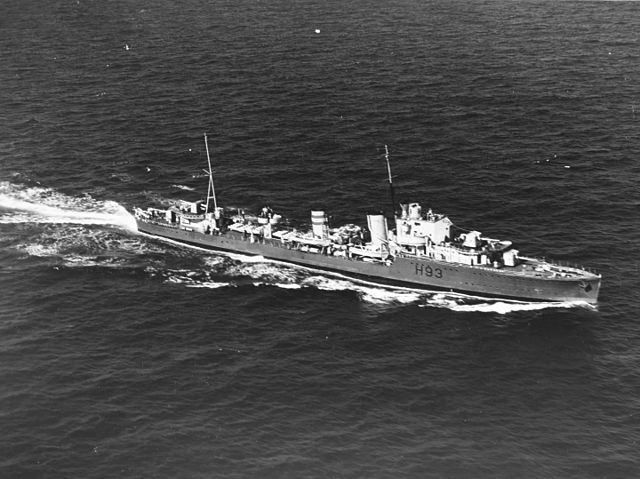
HMS Hereward in 1939, showing her Spanish Neutrality Patrols colors with a dark grey hull and light grey structures.
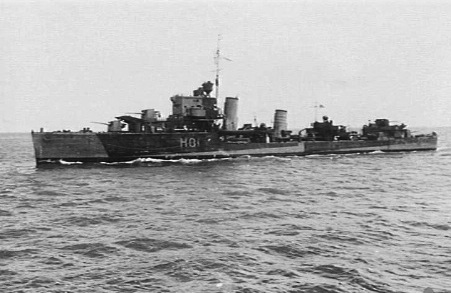
HMS Hoptsur mostly soldiered in the Mediterranean. She received a polular scheme here, made of broad black angular lines on standard light admiralty grey.
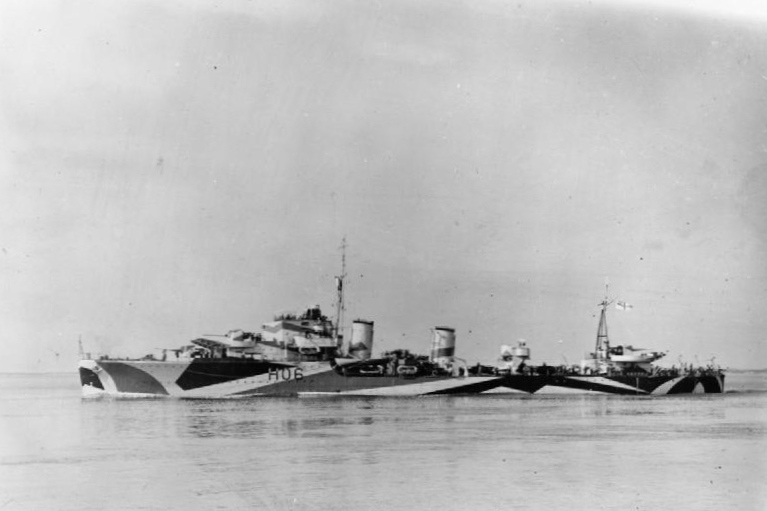

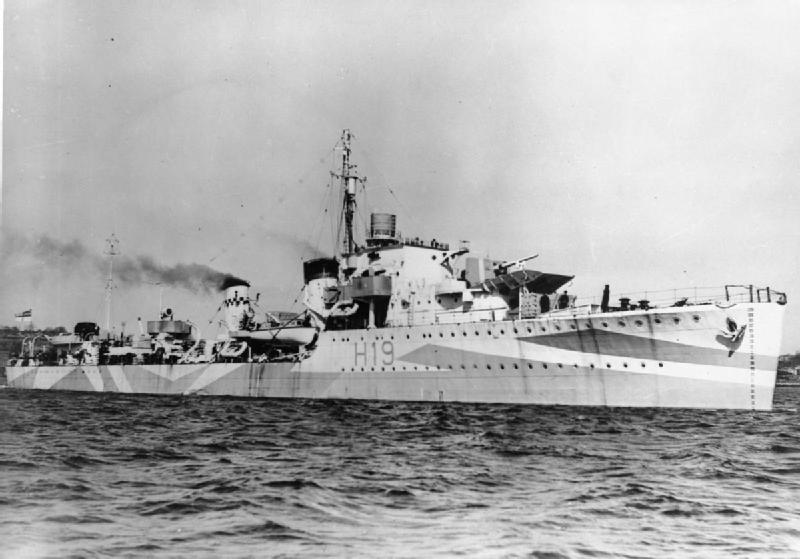
HMS Hurricane, Hesperus and Harvester showing variants of yheir typical “western approaches” pattern under the WAC. It was a blend of medium blue, dark grey or black lines and angular patterns. Some were more complex than others. Top: HMS Hurricane, mid: HMS Hesperus, bottom: HMS Harvester. The latter shows a 4-tones pattern with relatively light tones, dark forward and aft only.

ORP Garland with her late war (1944-45) pattern resembling the USN Measure 22 but cut forward.

HMS Havant as camouflaged in 1942
Wartime Modifications
From May 1940, the aft bank of torpedo tubes replacement by a QF 12-pounder Mk V anti-aircraft gun was to ibcrease their longer range AA defensive capabilities, while her after mast and funnel were cut down to improve its field of fire. Up to eight QF 20 mm Oerlikon AA guns were added later, notably on the bridge wings or abreast the searchlight platform. Depth charge stowage was increased to 44 and in 1943 (four G-H still afloat). The ‘Y’ gun was moved to the quarterdec and up to four depth charge throwers installed. The installation of a Huff-Duff radio direction finder on a short mainmast aft added to their capabilities, and up to 125 depth charges. Hedgehogs became mandatory.
Also, their initial director-control tower and rangefinde were replaced by a lighter Type 271 target-indication radar.The ‘A’ mount on Hotspur (‘B’ on Hero) saw the addition of an Hedgehog. The twin-gun mount QF six-pdr Hotchkiss were given low elevation angle mounts to deal with U-Boats at very close range, a critical gap in capabilities. The final radar installed was the Type 286 short-range radar for surface-search, adapted from the Royal Air Force (ASV radar). Earlier sets were only capable of forward scan.
Flotilla Leaders:
Just like for previous classes, the G and H had their own flotilla leaders built to an enlarged design. The main reason was the addition of a fifth 4.7-inch gun in ‘Q’ position between funnels. This was an adaptation of the F-class leader (HMS Faulknor). The first was HMS Grenville, for the G class; She was however shorter and heavier than the H class lead vessel (HMS Hardy), using the compact Yarrow-type side fired boilers. Hardy was beamier. Displacement rose to 1,445–1,465 long tons (1,468–1,489 t) standard, 1,953–2,033 long tons (1,984–2,066 t) deep load. for an overall length of 330–337 feet (100.6–102.7 m), beam of 33.75–34 feet (10.3–10.4 m), draught of 12 feet 6 inches (3.8 m). The crew was larger due to the command staff at 175 for Captain (D) fotilla commandr. The turbines were more powerful of 2,000 shp (1,500 kW) for 0.5 knots (0.93 km/h; 0.58 mph) extra speed. They were lost early.
The Havant class (1939)
The Havant class ships were laid down in 1938 initially after a Brazilian naval plan requesting six new destroyers of the G/H design at several yards, Vickers, White and Thornycroft (a pair each). They were all laid down in 1938, as the Javary class for the first being laid down. The others were named Jurua, jutahy, Juruena, Jaguaribe, and Japarua. Given the war erupted, the British Goevernment decided to requisition the six destroyers on 5 September 1939. Javary became HMS Havant, and was launched first in July 1939. The others followed in August to October 1939. However completion took time due to the conversion of all already installed indicators from metric to imperial, Portuguese to English, etc. They also differed from regular G-H by their topedoes tailored for Brazilian needs, the Mark X*:
Mark X*
Designed 1939, in Service 1940
Weight: 3,571 lbs. (1,620 kg), Length 23 ft 7.5 in (7.200 m)
Negative Buoyancy 606 lbs. (275 kg). 661 lbs. (300 kg) TNT warhead
Power: Wet-heater
Range/Speed 3,280 yds(3,000 m)/47 kts | 5,470 yds(5,000 m)/43 kts | 8,750 yds(8,000 m)/36 kts | 13,120 yds(12,000 m)/29 kts
They were optimized for anti-submarine work and different enough from the G-H. They completed without their ‘Y’ gun aft, and instead had no less than eight DC throwers, three racks, for a total of 110 depth charges. They were fitted with a combined rangefinder-director above the bridge. But their wartime modifications reasmbled the G-H-class: 12-pounder AA gun, aft torpedo tubes removed, extra 20 mm Oerlikons (bridge wings), Type 286 radar, then extra Oerlikons, Type 271 rada and rangefinder-director removed, A gun replaced by a Hedgehog and 12-pdr removed for up to 125 DCs, HF/DF mast installed aft.
⚙ Havant class specifications |
|
| Armament | 3x 4.7 in (120 mm) guns, 110 depth charges. |
Other users
 Buenos Aires class
Buenos Aires class
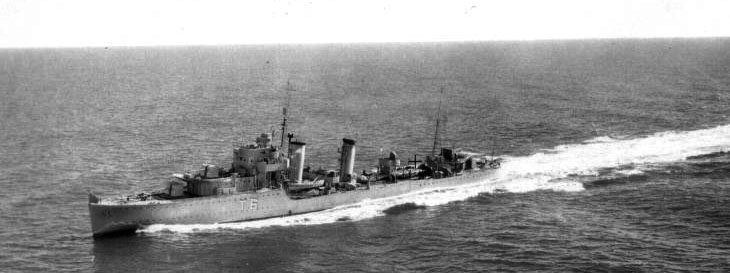
ARA Buenos Aires, Corrientes, Entre Rios, Misiones, San Juan, San Luis, Santa Cruz
Seven ships were ordered by the Argentine Navy before the Brazilians (which triggered their own order in response) they were known as the Buenos Aires class and delivered in 1938, built by Vickers Armstrongs and Cammell Laird as well as John Brown. One was lost due to a collision in 1941, but they remained in service until the early 1970s.
 Jurua class
Jurua class
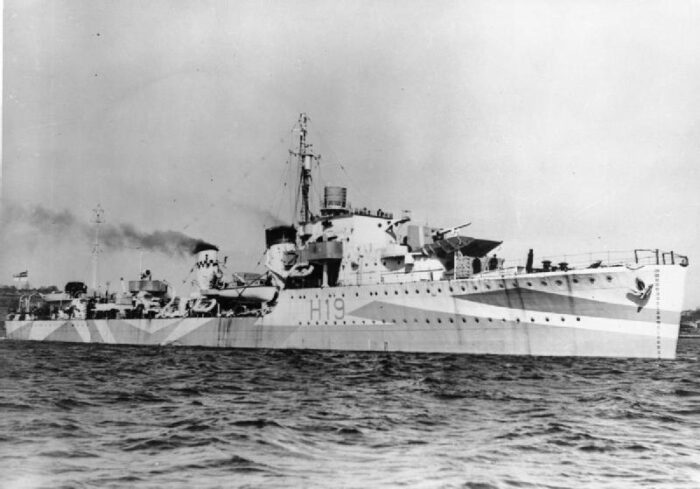
HMS Harvester, ex-Jurua in 1942
The six Jurua-class were ordered in 1938 in answer to the Argentinian class. But they were purchased at the outbreak of war and thus requisitioned wile in construction, some before launch, some after. The Brazilians were affected by this move and decided to create their own designs, which ended with the Acre class built at the Ilha das Cobras shipyard, stering with the H-class plans supplied by Britain and machinery, armament from the United States. They were completed in 1949–1951.
 Vasilefs Georgios class
Vasilefs Georgios class

The Royal Hellenic Navy ordered to modified G class at Yarrow in 1938, to be fitted however with German armament, 127-millimetre (5 in) guns, and 37-millimetre (1.5 in) AA guns. The exra weight made the sacrifice of torpedo tubes to just two per bank. The ships were delivered before requisition, and had to see the installation of the armament in Greece as the Germans refused to ship their armament to Britain for obvious reasons. So Vasilefs Georgios took part in the Greco-Italian War but was damaged by the Luftwaffe and scuttled to prevent capture. Raised, she became KMS Hermes (ZG3) on 21 March 1942 in Kriegsmarine service, and heavily damaged off Cape Bon in Tunisia (30 April 1943), scuttled on 7 May 1943. Her sister Vasilissa Olga escaped the same fate by fleeing to Alexandria in May 1941, joined the Allied forces. She was destroyed by the Luftwaffe while in Lakki Bay, Leros, 26 September 1943.
General Evaluation and Service
Neutrality Patrols
HMS Grenville and the G class at the start of World War II were assigned to the 1st Destroyer Flotilla (DF) in the Mediterranean Fleet. They were part of the French-British neutrality patrols during the Spanish Civil War of 1936–1939, watching over Italian and German moves to support the Nationaliists. HMS Garland which was under repair at Malta after a premature explosion of her depth charges at the start of the war, only by October–November 1939. Hardy and the H-class ships were assigned to the 2nd Destroyer Flotilla and like her G sisters, went into the Mediterranean. The 1st DF was transferred for duties to the Western Approaches Command, then the Nore Command at Harwich, with some ships diverted to the 22nd Destroyer Flotilla, escorting convoys and patrolling the home waters. HMS Gipsy was sunk on 21 November by a mine, and Grenville, the flotilla leader, on 19 January 1940. The 2nd DF meanwhile was transferred to Force K in Freetown, West Africa, to hunt down commerce raiders attempting to pass the cape and hit the Indian Ocean. Some were transferred to Bermuda to watch over the West Indies and were back home for intensive refits. After commissioning, HMS Handy and Hearty were renamed Harvester and Hesperus to avoid confusion with Hardy.
Norwegian Campaign
The Havant-class destroyers initially formed the 9th Destroyer Flotilla (9th DF) and were assigned to Western Approaches Command in ASW patrols and escort duty. HMS Havant, Hesperus, and Havelock were detached to the Home Fleet fighting in the Norwegian Campaign.
As for the G class, HMS Garland, Grafton, Gallant, Hasty and Hereward were in refit or escorts in the Norwegian Campaign and missed the battle of Narvik in April. The remaining ones were with the Home Fleet.
HMS Glowworm was separated from HMS Renown in a heavy storm on 8 April and fell on the heavy cruiser KMS Admiral Hipper and her escort destroyers. She was too close to disengage and at some point, so close she attempted to ram the cruiser, and was sunk while trying. Meanwhile, HMS Hardy, Havock, Hostile, Hotspur and Hunter were in the First Battle of Narvik on 10 April, claiming two German destroyers while loosing Hardy and Hunter, Hotspur being badly damaged but Hero sank U-50 off the Norwegian coast. She would also later took part in the Second Battle of Narvik, three days later. HMS Griffin and Hasty covered the allied evacuation from Namsos and Åndalsnes later and Havelock escorted transports for the evacuation of Narvik in June 1940. Garland was loaned to the Poles after repairs and operated in the Mediterranean, escorting convoys and then back to the Western Approaches Command.
Operation Dynamo and follow-up
By mid-May, the 2nd DF was sent to the Mediterranean: HMS Hostile, Hyperion, Hero, Hereward, Havock, and Hasty. The other G and Havant-class meanwhile took part in Operation Dynamo. HMS Grafton was torpedoed by U-62 on 29 May while rescuing men from Wakeful, later scuttled by Ivanhoe. HMS Grenade the same day (appropriately) blew up after being hit by Stukas. On 1 June, Havant was scuttled after a similar attack, Gallant and Greyhound damaged (same cause) while evacuating troops from Dunkirk. Harvester evacuated more troops from Saint-Valery-en-Caux in Operation Cycle. Griffin, Highlander, and Havelock also took part in Operation Aerial, evacuation from Saint-Nazaire and St. Jean de Luz down south.
The 9th DF however was sent back to Western Approaches Command by July-September 1940 as U-Boat losses amounted, and made a brief passage at the Portsmouth Command awaiting Operation Sea Lion that never took place. Harvester and Highlander sank U-32 on 30 October. By November 1940, the 9th DF became the 9th Escort Group and the Havants remained on escort duty until refits in 1941.
Mediterranean Campaign

HMS Hotspur had probably the most colorful and longest career of all H class destroyers, being discarded ultimately in the 1970s…
Back to the 2nd DF, these destroyers took part in the Battle of Calabria (Punta Stilo) on 7–8 July.
Two weeks later, Hasty, Hero, Hyperion and Havock escorted HMAS Sydney when meeting and two Italian light cruisers at the Battle of Cape Spada. They escorted convoys of the Mediterranean Fleet, Hostile hitting a mine on 23 August, Hyperion being torpedoes by the Submarine Serpente on 22 December.
Hotspur was reassigned to the 13th DF, Force H at Gibraltar in July as were soon Gallant, Greyhound, and Griffin. The latter two escorted Force H at the Battle of Dakar in September. Havock and Hasty sank the submarine Berillo on 2 October off Cyrenica. Gallant, Griffin and Hotspur sank the Italian submarine Lafolè on 18 October. Gallant, Greyhound, Griffin, were sent to the 14th DF and with Hero and Hereward took part in the Battle of Cape Spartivento on 27 November.
HMS Gallant, Greyhound and Griffin were covering a convoy to Malta on 10 January when Gallant lost her bow to a mine, being rescued by Griffin and towed to Malta but never repaired (constructive total loss after an aerial attack on 5 April 1942). On 19 January, Greyhound sank the the submarine Neghelli after she attacked her convoy and later the sub. Anfitre on 6 March. HMS Greyhound, Griffin, Hotspur, Hasty, Havock and Hereward took part in the Battle of Cape Matapan on 27–28 March. On 22 May off Crete, HMS Greyhound was sunk by Stukas as did Hereward a week later. Hotspur, Havock, Hero, and Hasty took part in the evacuations of Greece and Crete in May and supported the Syria–Lebanon Campaign in June 1942. These four H-class went on escorting convoys from Alexandria to Tobruk in July and to Malta until 1943. Hasty and Hotspur sank U-79 on 23 December off Tobruk.
To reinforce escorts for Operation Vigorous, Griffin and Hotspur in June 1942 were temporarily recalled.
HMS Griffin and Hotspur went the only ones sent that early to the Eastern Fleet, in February 1942. Havock, Hasty, Hero took part in the Second Battle of Sirte on 22 March. Hero was badly damaged and nearly finished off by axis bombers while in repairs at Malta. While back to Gibraltar for full repairs she ran aground off the Tunisian coast on 5/6 April and was scuttled. Meanwhile Eridge and Hurworth sank U-568 on 28 May.
ORP Garland was transferred to the Mediterranean in April 1944. She sank U-407 on 19 September and started back home a long refit from November 1944 just completed when the war ended.
Atlantic Campaign

ORP Garland had also quite a long and intersting carrier, mostly under a Polish crew. After May 1945 she carried so much food supplies to Belgium and the Netherlands it is estimated she saved the life of perhaps 100,000 starving people there. Perhaps partly in reconnaissance she was purchased by the Royal Netherlands Navy postwar and became HNLMS Marnix, for many more long years of service.
ORP Garland and the five surviving Havants were maintain in Atlantic convoy escort duties, with exceptions such as Operation Tiger (Mediterranean convoy in May with Harvester, Havelock, and Hesperus). ORP Garland took part in the Spitzbergen Raid in July 1942. Hurricane was badly damaged by Stukas in May 1942 stuck in repairs until 1943.
Hesperus was transferred to Force H in December 1941 to patrolled the strait of Gibraltar. She sank U-93 by ramming her on 15 January 1942.
In March 1942, the Havant-class became group leaders, Mid-Ocean Escort Force in 1942–1943. ORP Garland escorted Convoy PQ 16 to Murmansk in May 1943 badly damaged by bombers. On 26 December, Hesperus sank U-357, also by ramming.
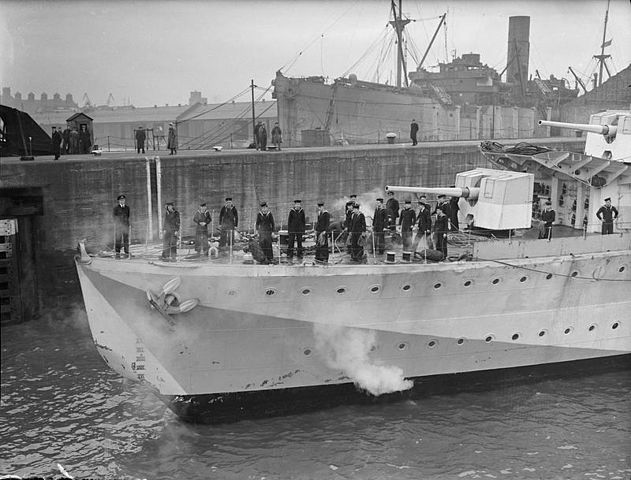
Ramming was a tactic commonly used by the destroyers, despite the fact the hull was not tailored for this, and damage was often heavy. But this is a good barometer of the Destroyer’s captains aggressivness. This was HMS Hesperus’ prow after such a ramming of Type VIIC U-357 on 26 December 1942 while protecting Convoy HX 219 near Rockall with the older V-class HMS Vanessa.
Hasty was torpedoed by a German E-boat, scuttled by Hotspur on 15 June. On 30 October, Hero sco-sank U-559 first spotted by a Wellesley bomber. Griffin was sent back home to start a conversion into a pure escort destroyer. Garland soldiered on in the North Atlantic until December 1943 and was sent to the southern routes, escorting convoys between Freetown and Gibraltar.
Hotspur and Hero were converted into escort destroyers in early 1943. Griffin and Hero were transferred to the Royal Canadian Navy in March and November 1943 as HMCS Ottawa and Chaudière. Hotspur saw her conversion completed only by October 1944. While escorting Convoy HX 228, she rammed U-444 on the night of 10-11 March. The FFL corvette Aconit finished off U-444. Her sister Harvester was sunk by U-432, in turn sunk by Aconit. Hesperus sank U-191 on 23 April, U-186 on 12 May. Hesperus continued escort missions until January 1945. She was transferred to home waters, worn out. Highlander and Hurricane continued escort but the latter was torpedoed by U-415 on 24 December, scuttled by Watchman.
HMS Havelock, HCMS Ottawa and Chaudière escorted North Atlantic convoys until transferred to for Operation Overlord in May 1944. Chaudière with others at HX 280 sank U-744 on 6 March 1944. Ottawa sank U-678 (with HMS Statice) on 6 July, U-621 (with Chaudière) on 16 August and U-984 (with Chaudière) on the 18th.
Ottawa, Chaudière and Hotspur also had lengthy overhauls starting by late 1944, the one of Hotspur ending in March 1945. She was patrolled the Irish Sea on V-Day. Ottawa had her refit completed in February 1945. Chaudière’s was still incomplete in May 1945. Highlander an iceberg on 15 April and ended the war under repair. Havelock and Hesperus and No. 201 Squadron RAF aircraft sank U-242 in the Irish Channel on 30 April 1945.
Postwar
The surviving G-H class ships were clearly obsolete and worn-out by May 1945. Ottawa repatriated Canadian troops until paid off in October 1945, sod for BU in 1946. Chaudière was in poor shape and paid off in August 1945, BU in 1950. ORP Garland basically fed the starving Dutch and Belgian towns and returned to the Home Fleet, placed in reserve by August 1946, purchased by the Royal Netherlands Navy in November 1947 as HNLMS Marnix, a training ship until 1964. Probably the most interesting destroyer career of the whole G class.
Hotspur, the most interesting of the H class, remained in service until 1948, sold to the Dominican Republic as Trujillo and then Duarte in 1962, sold for scrap in 1972.
Havelock and Hesperus escorted the exiled Norwegian government back to Norway in May 1945. They became target ships, BU 1946 1947.
Highlander also became a target ship after repairs complete, scrapped by May 1947.
G class Destroyers
 HMS Gallant (H59)
HMS Gallant (H59)
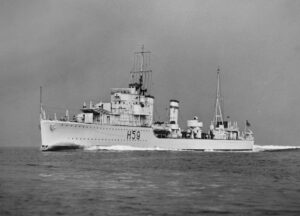 HMS Gallant was laid down at Alexander Stephen and Sons Yard in Linthouse on 15 September 1934, launched on 26 September 1935 and completed on 25 February 1936. She was assigned to the 1st Destroyer Flotilla, Mediterranean Fleet, patrolled Spanish waters in the Civil War fpr the Non-Intervention Committee. She pulled out a merchantman grounded between Almeria and Málaga on 20 December. She was mistook for a Republican DD and attacked by Spanish Nationalist aircraft off Cape San Antonio on 6 April 1937 but not damaged. Next she had an overhaul at Sheerness (31 May-21 July). By September 1939, with the flotilla she transited from the Med to the Western Approaches Command, Plymouth, in October, then Nore Command, Harwich. On 2 February 1940 with Griffin she rescued the crew from the oil tanker British Councillor which hit a mine. She escorted the Convoy HN 12 replacing the sunken HMS Duchess from 18 February and rescuing 12 from the Swedish Santos near Duncansby a week later. On 20 March she escorted the HMCs Cilicia and Carinthia after they collided.
HMS Gallant was laid down at Alexander Stephen and Sons Yard in Linthouse on 15 September 1934, launched on 26 September 1935 and completed on 25 February 1936. She was assigned to the 1st Destroyer Flotilla, Mediterranean Fleet, patrolled Spanish waters in the Civil War fpr the Non-Intervention Committee. She pulled out a merchantman grounded between Almeria and Málaga on 20 December. She was mistook for a Republican DD and attacked by Spanish Nationalist aircraft off Cape San Antonio on 6 April 1937 but not damaged. Next she had an overhaul at Sheerness (31 May-21 July). By September 1939, with the flotilla she transited from the Med to the Western Approaches Command, Plymouth, in October, then Nore Command, Harwich. On 2 February 1940 with Griffin she rescued the crew from the oil tanker British Councillor which hit a mine. She escorted the Convoy HN 12 replacing the sunken HMS Duchess from 18 February and rescuing 12 from the Swedish Santos near Duncansby a week later. On 20 March she escorted the HMCs Cilicia and Carinthia after they collided.
Refitted at Southampton (28 March-30 April) she returned to Harwich and on 9/10 May with Bulldog rescued the crew from HMS Kelly sank by E-boat in the North Sea. She took part in the Dunkirk evacuation, was near missed by a bomb on 29 May (steering off, leaking hull) and repaired at Hull. She intercepted a German minelaying sortie on 5/6 June off Lowestoft with HMS Walpole. After a refit at Chatham she was assigned to the 13th Destroyer Flotilla, North Atlantic Command, Gibraltar, 30 July ecorting HMS Argus loaded with Hurricanes as well later for Operation Hurry, SW of Sardinia, to fly her planes to Malta on 2 August. Nexh she was assigned to Force H and later with Griffin and Hotspur she sank the Italian submarine Lafolè, east of Gibraltar. She escorted HMS Barham, the cruisers Berwick and Glasgow in Operation Coat by early November. Then she was transferred to the 14th DF in Malta from 10 November and took part in the Battle of Cape Spartivento (Operation Collar).
On 10 January 1941 in Operation Excess, there was a TB attack off Pantellaria and she struck a mine, detonating her forward magazine, severing her bow and killing 65, injuring 15 more. HMS Griffin rescued most of her crew and she was towed stern-first by the powerful Tribal class HMS Mohawk to Malta. Repairs dragged on due to the isolation and by 5 April 1942, a raid on Valletta left her wrecked by bomb splinters. She was beached at Pinto’s Wharf and was declared a constructive total los. The hull was stripped to repair others DDs, and she ended as a blockship at St Paul’s Island by September 1943, then BU in 1953.

 HMS/ORP Garland (H37)
HMS/ORP Garland (H37)
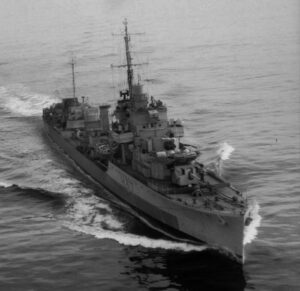 HMS Garland was laid down at Fairfield Shipbuilding & Engineering Co. Govan on 22 August 1934. She was laid down on 24 October 1935 and completed on 3 March 1936. She was assigned to the 1st DF like her sisters, evacuated British and foreign nationals from Barcelona and other ports in 1936-37, patrolled the coast until 1938 and was was overhauled at Sheerness, low-pressure turbines repaired. She was patrolling off Cyprus by July 1939, and as the war erupted, was sent to Alexandria from Aden on 6 September, escorting a convoy to Malta from the east. On 17 September some her her depht charges detonated prematurely, and she was towed back to Alexandria for repairs, then Malta until 8 May 1940. While there, she was loaned to the Polish Navy on 3 May 1940 as ORP Garland.
HMS Garland was laid down at Fairfield Shipbuilding & Engineering Co. Govan on 22 August 1934. She was laid down on 24 October 1935 and completed on 3 March 1936. She was assigned to the 1st DF like her sisters, evacuated British and foreign nationals from Barcelona and other ports in 1936-37, patrolled the coast until 1938 and was was overhauled at Sheerness, low-pressure turbines repaired. She was patrolling off Cyprus by July 1939, and as the war erupted, was sent to Alexandria from Aden on 6 September, escorting a convoy to Malta from the east. On 17 September some her her depht charges detonated prematurely, and she was towed back to Alexandria for repairs, then Malta until 8 May 1940. While there, she was loaned to the Polish Navy on 3 May 1940 as ORP Garland.
Under her new Polish crew she escorted a convoy to and from Greece by late June 1940 and took part in Operation Hats, she was lightly damaged by Italian aircraft on 31 August. Next she was transferred to the Western Approaches Command, 10th Escort Group. On 13 November while escorting Revenge she was badly damaged by a storm (a month repairs) and lost tow men overboard. By January 1941 while received a new ASDIC she was transferred to the 14th Escort Group, Home Fleet escorting a tanker for the Allied landing on Spitsbergen, July 1940. Next she was in the Escort Group B3, North Atlantic. She joined her fellow DD ORP Piorun in Operation Halberd, to Malta, escorting back HMS Nelson to Gibraltar (torpedoed). Next she was in Escort Group B3, refitted 28 February-5 May 1942 in Middlesbrough, then escort Convoy PQ 16. On 27 May she had a near-miss from a Ju 88 bomber on her starboard. Both forward gun crewswere killed as well as the starboard Oerlikon and Vickers HMGs (22 killed, 37 wounded), loosing also her fire-control director and rangefinder. She was detached to Murmansk for temporary repairs for over a month and ended on 4 July at Troon with QP 13 for permanent repairs until 21 September. Next in Escort Group B3 she had a refit from May to September 1943 and was reassigned to thee 8th Support Group, to the Azores to build airbases after the Portuguese greenlight. From November to April 1944 she was based in Freetown to escort convoys via the Cape. In May she was in the 14th DF, Mediterranean Fleet and soldiering in the Aegean. On 19 September 1944 she co-sank U-407 off Santorini. She took part in the liberation of Greece.
On 20 Novembe back home she started a long refit at Devonport until 31 March 1945. Assigned to the 8th DF Western Approaches Command she learned the end of the war underway. Famine stroke the Nethermlands and Belgium so she carried emergency supplies there. She took part in Operation Deadlight (U-Boats mass scuttling) and in 1946 patrolled Norwegian waters. She was assigned to the Polish Squadron at Rosyth and was ultimately paid off, loan terminated, entering the Category C reserve. She had a new “career” as HNLMS Marnix, with the Royal Netherlands Navy as school ship and ASW training ship. A frigate from 1952 she was decommissioned on 31 January 1964 after a last modernization, sold for BU.
 HMS Gipsy (H63)
HMS Gipsy (H63)
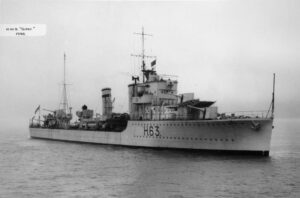 HMS Gipsy was laid down on 4 September 1934, launched on 7 November 1935 and completed on 22 February 1936. She served with the 20th DF, Home Fleet, then joined her sisters in the Med with the 1st DF and from 1936 patrolled during the Spanish Civil War. She notably took part in the Barcelona evacuation. On 13 February 1937 with Havock between Gibraltar and Malta they were attacked by Republican aircraft taking them for Republican DDs. Bombs fortunately missed but the AA crews opened fire anyway and drove them out. She was later refitted at Devonport until 30 July 1938.
HMS Gipsy was laid down on 4 September 1934, launched on 7 November 1935 and completed on 22 February 1936. She served with the 20th DF, Home Fleet, then joined her sisters in the Med with the 1st DF and from 1936 patrolled during the Spanish Civil War. She notably took part in the Barcelona evacuation. On 13 February 1937 with Havock between Gibraltar and Malta they were attacked by Republican aircraft taking them for Republican DDs. Bombs fortunately missed but the AA crews opened fire anyway and drove them out. She was later refitted at Devonport until 30 July 1938.
In September 1939 she was in the 1st DF, including contraband control in the Eastern Mediterranean from Alexandria but was transferred to the Western Approaches (Plymouth) in October and on 12 November she collided with HMS Greyhound by night underway to Harwich and the 22nd DF. Light damage. She rescued three German airmen on 21 November. She was sent in ASW patrol with HMS Griffin, Keith, Boadicea, ORP Burza and Grom in the North Sea. She tirgerred two Magnetic mines previously air-dropped. The detonation almost broke her in half. She sank on the edge of the deepwater channel with 31 dead inc. captain Lt-Cdr Crossley, 115 rescued.
This led to an inquiry which determined that the harbour defences, while on alert, the AA Battery station saw these seaplanes and plotted their mines, but inaccurately. Gipsy’s crew was not on alert at the time and unprepared. Her wreck remained upright on the seabed and was later gradually scrapped and recovered between June 1940 and February 1944.
 HMS Glowworm (H92)
HMS Glowworm (H92)
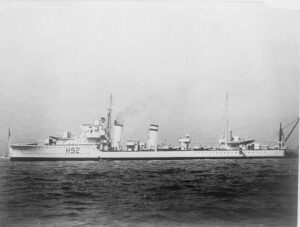 HMS Glowworm was laid down at John I. Thornycroft & Co. Woolston on 15 August 1934, launched on 22 July 1935 and completed on 22 January 1936. She served in the 1st Destroyer Flotilla, Mediterranean Fleet and cruised in August-September 1936 with Graftonn escorting King Edward VIII’s yacht Nahlin in the eastern Mediterranean.
HMS Glowworm was laid down at John I. Thornycroft & Co. Woolston on 15 August 1934, launched on 22 July 1935 and completed on 22 January 1936. She served in the 1st Destroyer Flotilla, Mediterranean Fleet and cruised in August-September 1936 with Graftonn escorting King Edward VIII’s yacht Nahlin in the eastern Mediterranean.
Next she patrolled Spanish water and was refitted at Portsmouth (27 May to 8 June 1937) then Portsmouth for another refit until 25 July 1938.
She escorted also SS Strathnaver between Malta and Alexandria (Munich Crisis) and HMS Arethusa to Aden. In night exercises on 16 May 1939 she collided wit HMS Grenade, repaired in Alexandria and Malta. When the war broke out she was in Alexandria and was transferred to the Western Approaches in October, with Gallant, Grafton, and Greyhound in Plymouth. She was in convoy escort duties/ASW patrols until 12 November and reassigned to the 22nd Destroyer Flotilla in Harwich, for North Sea patrol/escort. On 22 February 1940 she was rammed while anchored in port by the Swedish Rex, off Outer Dowsing. Damage was repaired at a commercial dockyard in Hull. She returned to the 1st DF, Home Fleet and Scapa Flow on 20 March.
On 5 April, she escorted HMS Renown with Greyhound, Hero, and Hyperion for Operation Wilfred (minelaying in Norwegian waters).
On 7 April, Glowworm was detached to look up for a man lost overboard.
A fatal decision: On the morning of 8 April while underway back to Renown she stumbled upon the destroyers Z11, Z18 in thick fog in the morning. They were parft of the escort of KMS Admiral Hipper, in Operation Weserübung. She opened fire and signalledg for help but only had Admiral Hipper spotting her at 09:50. She fired from 8,400 m (27,600 ft) and hit Glowworm at her fourth salvo. Her guns were radar-directed and not affected by the smoke launched by the British destroyer. Later she was founded even close, at 10.5-cm battery range, and was pummelled, loosing her radio room, bridge, forward A gun, then engine room, captain’s cabin, mast severed, had a short circuit and a fire started.
At 10:10, Captain LtCdr Gerard Roope fired five torpedoes from 800 m (2,600 ft) but they missed since Hipper’s captain expected this and pointed her bow pointed at Glowworm. The latter managed to have her second torpedo mount working, but Hipper rushed towards so close when emerging from the smoke a hard turn to starboard was ordered to ram her. Hipper was slow and she managed to ram her abaft the anchor. Not made for this, she lost her bow and scrapped along the cruiser’s side. Hipper was holed and flooded by 500 t of seawater. In between her AA guns managed to wreck Glowworm, on fire and drifting. Her boilers suddenly exploded at 10:24, and she sank rapidly with 109 men trapped inside. Hipper started to rescue 40 survivors and Lieutenant Ramsay. Captain Roope drowned and was later posthumously awarded the Victoria Cross, first VC recipient of this war. Ramsay was awarded the DSO.
 HMS Grafton (H89)
HMS Grafton (H89)
 HMS Grafton was laid down on 30 August 1934 at John I. Thornycroft & Co, launched on 18 September 1935 and completed on 20 March 1936. She was assigned to the 20th DF after commissioning then Mediterranean 1st DF, escorted King Edward VIII’s yacht, patrolled Spanish waters and was in refit at Malta when the war started. She was then transferred to the Western Approaches Command (Plymouth) October 1939 and by November, reassigned to the 22nd DF in Harwich, Nore Command. On 10 January 1940 she was transferred to 1st DF Harwich, inspecting ships travelling between German and Dutch ports. Between 26 March and 14 April she was in overhaul at Hull, Brigham & Cowan Yd. Reassigned to the Home Fleet she escorted convoys to Norway until 11 May.
HMS Grafton was laid down on 30 August 1934 at John I. Thornycroft & Co, launched on 18 September 1935 and completed on 20 March 1936. She was assigned to the 20th DF after commissioning then Mediterranean 1st DF, escorted King Edward VIII’s yacht, patrolled Spanish waters and was in refit at Malta when the war started. She was then transferred to the Western Approaches Command (Plymouth) October 1939 and by November, reassigned to the 22nd DF in Harwich, Nore Command. On 10 January 1940 she was transferred to 1st DF Harwich, inspecting ships travelling between German and Dutch ports. Between 26 March and 14 April she was in overhaul at Hull, Brigham & Cowan Yd. Reassigned to the Home Fleet she escorted convoys to Norway until 11 May.
At the Siege of Calais she Arethusa and Galatea in naval gunfire support, helping the 30th Motor Brigade to disengage on 26 May. She evacuated 1,600 troops from La Panne and Bray (Dunkirk NE) on the 27th and on the 29th, she rescue survivors from HMS Wakeful savaged by the E-boat S-30 off Nieuwpoort. As it happened she was hit at her stern by a torpedo from U-62. There was a secondary explosion with the depht charges and later under the bridge, killing the whole staff. Keel broken, she remained afloat for all to be rescued rescued by Ivanhoe and Malines. Ivanhoe then gunned down Grafton as she could not be towed.
 HMS Grenade (H86)
HMS Grenade (H86)
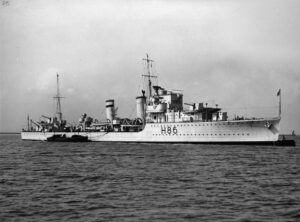 HMS Grenade was laid down at Alexander Stephen and Sons in Linthouse on 3 October 1934, launched on 12 November 1935 and completed on 28 March 1936. She was assigned to the 1st DF, Mediterranea and had a post-completion overhaul at Malta in March-April 1937. She was later refitted in Chatham in May-July 1938 and operated in the Red Sea in October. From September 1939 she was in Alexandria before being transferred to the Western Approaches. On 7 November she cllided with HMS Grenville, repairs completed byl 9 December. Next she was in contraband control duties and rescued 117 survivors from Grenville after she hit a mine on 19 January 1940. After a refit in London (27 January-27 February) she was struck (not rammed) by the ocean liner SS Orion just while making her post-refit run. She was fully repaired in Harwich until 3 April, reassigned to Home Fleet, Scapa Flow.
HMS Grenade was laid down at Alexander Stephen and Sons in Linthouse on 3 October 1934, launched on 12 November 1935 and completed on 28 March 1936. She was assigned to the 1st DF, Mediterranea and had a post-completion overhaul at Malta in March-April 1937. She was later refitted in Chatham in May-July 1938 and operated in the Red Sea in October. From September 1939 she was in Alexandria before being transferred to the Western Approaches. On 7 November she cllided with HMS Grenville, repairs completed byl 9 December. Next she was in contraband control duties and rescued 117 survivors from Grenville after she hit a mine on 19 January 1940. After a refit in London (27 January-27 February) she was struck (not rammed) by the ocean liner SS Orion just while making her post-refit run. She was fully repaired in Harwich until 3 April, reassigned to Home Fleet, Scapa Flow.
As the Invasion of Norway commenced in April, HMS Grenade was escorting the Convoy ON25, when recalled for the Home Fleet and with HMS Encounter she escorted the oil tanker British Lady to Flakstadøya (Lofoten) as a refuelling and repair base. Next she escorted HMS Warspite and HMS Ark Royal in Norwegian waters. She then covered the allied evacuation from Namsos in May and rescued men from the crippled French destroyer Bison (badly damaged by a Ju 87 Stuka on 3 May). An air raid at the time causes near misses and a shower of splinters while she rescued 36 sailors, twenty later died of their wounds, badly burnt. She was back at Scapa Flow on 5 May, transferred to the English Channel. There, she collided with the ASW trawler Clayton Wyke on 14 May (fog), repaired at Sheerness on 25 May. She took part in the evacuation from Dunkirk northern Channel, covering the evacuation force and rescuing 33 from the coaster SS Abukir (E-boat kill). She returned to Dunkirk in the night of 28/29 May but was attackd by Stukas the following day. Near misses already shook her bu she took two direct bomb hits, killing 14, wounded 4 more. In fire she was cast off from her berth and drifted into the harbour channel, towed for a time by the trawler John Cattling to the west side of the outer harbour. But there, her magazines exploded, she sank for good.
 HMS Grenville (H03)
HMS Grenville (H03)
 HMS Grenville was the class Flotilla leader, laid down at Yarrow & Co. in Scotstoun on 29 September 1934, launched on 15 August 1935 and completed on 1 July 1936. Her career was short: After a time at the 20th Destroyer Flotilla she became flagship of the 1st Destroyer Flotilla, Mediterranean Fleet. For ten months she patrolled the Spanish coast, Western Mediterranean. She had a refit at Portsmouth in May-June 1937 and was back to the Mediterranean, then had another refit at Portsmouth in June-July 1938. From September 1939, she was deployed in the Mediterranean and transferred on 22 October with Griffin, Grenade and Gipsy to the Western Approaches Command, Plymouth. HMS Grenville and Grenade collided by night on 7/8 November. Her No. 3 boiler room was flooded and she was repaired at HM Dockyard, Devonport until 1 December. Meanwhile her flotilla was sent to the Nore Command, Harwich. Grenville was reunited on 3 December and took part in many stories against shipping traffic off the Dutch-German North Sea coasts. On 19 January she struck a mine, 23 miles (37 km) east of the Kentish Knock Light Vessel. 77 went down with her, the rest were rescued by neighbouring ships.
HMS Grenville was the class Flotilla leader, laid down at Yarrow & Co. in Scotstoun on 29 September 1934, launched on 15 August 1935 and completed on 1 July 1936. Her career was short: After a time at the 20th Destroyer Flotilla she became flagship of the 1st Destroyer Flotilla, Mediterranean Fleet. For ten months she patrolled the Spanish coast, Western Mediterranean. She had a refit at Portsmouth in May-June 1937 and was back to the Mediterranean, then had another refit at Portsmouth in June-July 1938. From September 1939, she was deployed in the Mediterranean and transferred on 22 October with Griffin, Grenade and Gipsy to the Western Approaches Command, Plymouth. HMS Grenville and Grenade collided by night on 7/8 November. Her No. 3 boiler room was flooded and she was repaired at HM Dockyard, Devonport until 1 December. Meanwhile her flotilla was sent to the Nore Command, Harwich. Grenville was reunited on 3 December and took part in many stories against shipping traffic off the Dutch-German North Sea coasts. On 19 January she struck a mine, 23 miles (37 km) east of the Kentish Knock Light Vessel. 77 went down with her, the rest were rescued by neighbouring ships.
 HMS Greyhound (H05)
HMS Greyhound (H05)
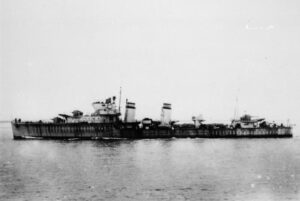 HMS Greyhound was laid down at Vickers Armstrongs (Barrow-in-Furness) on 20 September 1934, completed on 1 February 1936. She was first assigned to the 20th DF then 1st DF, Med Fleet, and on 17 November 1937 she was in Mudros looking for the British steamship African Mariner (smuggler to Spain). Spotted by an aircraft from HMS Repulse, she was intercepted by Greyhound, boarded and interned into Malta. She came from Odessa-Novorossisk. After her Portsmouth refit between 7 June and 23 July 1938 she escorted SS Strathnaver during the Munich Crisis, Arethusa to Aden and on 25 January 1939, evacuated the British Embassy from a besieged Barcelona. She left under near-misses from the Republican artillery. In October she was on the Western Approaches. On 12 November she collided with Gipsy, lighlty damaged. She rescued survivors from SS Simon Bolivar and SS Torchbearer (mines) on 18-19th. She escorted coastal convoys in December and was assigned back to the reconstituted 1st DF. On 14 January she captured the German blockade runner Phaedra, North Sea. After another refit she served with the Home Fleet.
HMS Greyhound was laid down at Vickers Armstrongs (Barrow-in-Furness) on 20 September 1934, completed on 1 February 1936. She was first assigned to the 20th DF then 1st DF, Med Fleet, and on 17 November 1937 she was in Mudros looking for the British steamship African Mariner (smuggler to Spain). Spotted by an aircraft from HMS Repulse, she was intercepted by Greyhound, boarded and interned into Malta. She came from Odessa-Novorossisk. After her Portsmouth refit between 7 June and 23 July 1938 she escorted SS Strathnaver during the Munich Crisis, Arethusa to Aden and on 25 January 1939, evacuated the British Embassy from a besieged Barcelona. She left under near-misses from the Republican artillery. In October she was on the Western Approaches. On 12 November she collided with Gipsy, lighlty damaged. She rescued survivors from SS Simon Bolivar and SS Torchbearer (mines) on 18-19th. She escorted coastal convoys in December and was assigned back to the reconstituted 1st DF. On 14 January she captured the German blockade runner Phaedra, North Sea. After another refit she served with the Home Fleet.
On 5 April she escorted Renown in Operation Wilfred. She was in Vestfjord with the 2nd DF to Ofotfjord on 10 April (battle of Narvik) and later covered their withdrawal. She was near-missed and damaged at Scapa Flow on 18 April, repaired at Gravesend until 19 May.
She took part in the Siege of Calais with Grafton by naval gunfire on 25-26 May. On the 28-29th she evacuated 1,360 men from Dunkirk and dodge Stuka attacks, joining ORP Błyskawica. After her repairs on 17 June she was in Dover. On 30 July with Gallant she escorted HMS Argus to Gibraltar and Operations Hats.
She was present in the Battle of Dakar on 23 September against Vichy French Forces with HMS Fury, and HMAS Australia. She co-claimed the destroyer L’Audacieux, escorted Barham, Berwick and Glasgow in Operation Coat and was assigned to the 14th DF in Alexandria. She was at the Battle of Cape Spartivento and Operation Collar, then Operation Excess in January 1941, co-claiming the sub Neghelli on 19 January while underway to Piraeus. By late January she joined Juno, Jervis, and Janus to escort a wounded HMS Illustrious from Malta to Alexandria. She sank the submarine Anfitrite on 6 March while protecting the Convoy GA.8 to Greece. She took part in the Battle of Cape Matapan, escorting the three battleships, even initiating the night action as it was her searchlight which found and illuminated the first Italian cruiser. With Griffin she then engaged escorting Italian destroyers and later snak the sailing ship Romagna on 17 April off Apollonia with HMAS Vendetta. On 6 May she provided cover for Operation Tiger to Egypt. She escorted Warspite off Crete after the airbone invasion on 22 May and met cruisers in Kythira Strait. A massive Stuka attack from StG 2 managed to hit her with three bombs. She sank a few minutes afters with few survivors, rescued by HMS Kingston and Kandahar. 6 officers and 74 sailors went down. A few more were later rescued by the Germans.
 HMS Griffin (H31)
HMS Griffin (H31)
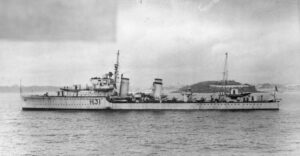 HMS Griffin was laid down on 6 March 1936. She was transferred to the RCN on 1 March 1943. Like the others she had a similar path, 20th DF then 1st DF Mediterranean, escorted SS Strathnaver, Arethusa, collided with Shikari on 2 February 1939. On 3 September she was in Alexandria, 1st DF but by October back home, and 7 October she escorted the troop ship Mohamed Ali El-Kebir from Avonmouth to Gibraltar, cound not prevent U-38 to sink her on the Western Approaches, 230 nm (430 km) west of Bloody Foreland (Ireland), 96 went down, Griffin attacked and chased off th U-Boat and came back to rescued 766 survivors, landed at Greenock.
HMS Griffin was laid down on 6 March 1936. She was transferred to the RCN on 1 March 1943. Like the others she had a similar path, 20th DF then 1st DF Mediterranean, escorted SS Strathnaver, Arethusa, collided with Shikari on 2 February 1939. On 3 September she was in Alexandria, 1st DF but by October back home, and 7 October she escorted the troop ship Mohamed Ali El-Kebir from Avonmouth to Gibraltar, cound not prevent U-38 to sink her on the Western Approaches, 230 nm (430 km) west of Bloody Foreland (Ireland), 96 went down, Griffin attacked and chased off th U-Boat and came back to rescued 766 survivors, landed at Greenock.
She was in Harwich by November, North Sea convoy escort, rescuing survivors from Gipsy (mine) on 21 November. Damaged, repair until 6 December she was transferred to the Home Fleet on April 1940 and sortied on 7 April for escort missions to Norway, and on the 26th with HMS Acheron she captured the German trawler Schiff 26 bound for Narvik, disguised as the Dutch ‘Polares’. Documents of encryptions found aboard were sent to Bletchley Park and helped breaking the naval Enigma codes. Next she evacuated allied troops from Namsos, rescued survivors from Afridi on 3 May. The Stukas which claimed her also attacked HMS Griffin. Transferred to the 13th DF, North Atlantic Command, Gibraltar, she escorted the capital ships for the Battle of Dakar. On 20 October she sank the subs Lafolè off Melilla, escorted Barham, Berwick, Glasgow in Operation Coat and joined the 14th DF in Alexandria taking part in the Battle of Cape Spartivento on 27 November as well as Operation Excess, assisting Gallant (mine) on 10 January 1941. In the Red Sea she escorted HMS Formidable for Operation Canvas. With capital ships she took also part in the Battle of Cape Matapan on 28–29 March and attacked the Italian escorts with Greyhound lost in a smokescreen. With HMAS Stuart, Gnat she bombarded Axis positions near Sollum, Egypt on 15 April. She covered evacuations of troops from Greece by late April. On the 25th she escorted the damaged Dutch troop ship Pennland to Megara and rescued 300 survivors from the stricken Pennland, scuttled by gunfire. On 27 April she rescued 50 survivors from HMS Diamond and Wryneck sank by Stukas in the Sea of Crete. She also covered a convoy from Alexandria to Malta (8 May) and covered the final evacuation of Crete, taking herself 720 men from Souda Bay.
She was in Operation Exporter, escorting HMAS Perth shelling Vichy French positions in Lebanon, on 2 July. She escorted convoys to and from Tobruk from July to November. On the 25th she was escorting HMS Barham when she was torpedoed by U-331. She escorted HMS Naiad when bombarding Derna in December and was assigned to the 2nd DF, escorting convoys to Malta in January-February 1942. She was transferred to the Eastern Fleet, Indian Ocean, by late February, assigned to Force A in April 1942 but returned to the Mediterranean for Operation Vigorous, to Malta in June, then back to the Eastern Fleet escorting convoys before going home, and be converted as an escort destroyer in September 1942.
This started on 2 November in Southampton but on 1 March 1943 she was transferred to the Royal Canadian Navy, recommissioned on 20 March and renamed HMAS Ottawa on 10 April, officially donated on 15 June. She took the head of Escort Group C5 from Newfoundland to Derry until May 1944, then 11th Escort Group (Kootenay, Chaudière, Gatineau, St. Laurent) taking part in D-Day. This group sank U-678, U-621 and U-984 in the area. Ottawa was refitted in St. John’s (12 October 1944-26 February 1945). On 11 March she collided with HMCS Stratford off Halifax and repaired. Postwar she ferried Canadian troops back to Canada until PO on 31 October, sold for BU on August 1946.
H class Destroyers
 HMS Hardy (H87)
HMS Hardy (H87)
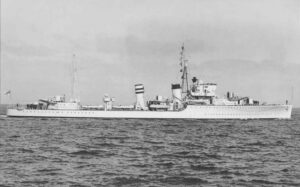 HMS Hardy was the H class Flotilla leader. She was laid down at Cammell Laird & Company in Birkenhead on 30 May 1935, launched on 7 April 1936 and completed on 11 December 1936.
HMS Hardy was the H class Flotilla leader. She was laid down at Cammell Laird & Company in Birkenhead on 30 May 1935, launched on 7 April 1936 and completed on 11 December 1936.
-Spanish waters from 1937, civil war, bombed Palma Majorda Rep. Planes.
-Sept.1939: Freetown, Commerce Raiders hunt.
-Home Fleet March 1940, 2nd DF Operation Wilfred 6 April.
-Battle of Narvik: Sank Z21 Wilhelm Heidkamp.
-Under Captain Warburton-Lee, sank by two other German DDs, 10 April 1940.
 HMS Hasty (H24)
HMS Hasty (H24)
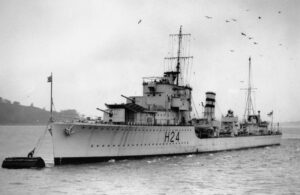 HMS Hasty was laid down at William Denny & Brothers, Dumbarton on 15 April 1935. She was launched on 5 May 1936 and completed on 11 November 1936.
HMS Hasty was laid down at William Denny & Brothers, Dumbarton on 15 April 1935. She was launched on 5 May 1936 and completed on 11 November 1936.
-Mediterranean Fleet 1937-39.
-Based in Freetown October 1939, German commerce raiders, Force K.
-April 1940 covered the evacuation from Namsos.
-Mediterranean Fleet, Battle of Calabri, Battle of Cape Spada July 1940.
-Battle of Cape Matapan March 1940
-Evacuations from Greece and Crete (April-May).
-June 1941 Syria-Lebanon Campaign
-Mediterranean Fleet ecorts to Malta and Alexandria 1941-42
-Second Battle of Sirte March 1942
-Operation Vigorous 15 June 1942: Torpedoed by a German German E-boat, so badly damaged she was scuttled.
 HMS Havock (H43)
HMS Havock (H43)
 HMS Havock was laid down on 15 May 1935 and launched on 7 July 1936, completed on 16 January 1937.
HMS Havock was laid down on 15 May 1935 and launched on 7 July 1936, completed on 16 January 1937.
-Spanish Civil War 1936–1939, arms blockade (Mediterranean Fleet).
-Freetown fall 1939: searched for German commerce raiders
-April 1940: First Battle of Narvik
-Mediterranean Fleet May 1940, convoys to Malta.
-Battle of Cape Spada July 1940
-Battle of Cape Matapan March 1941
-Evacuation of Greece April 1941, damaged during the Battle of Crete
-Syria–Lebanon Campaign June 1941.
-Convoys to Tobruk, damaged in October.
-First Battle of Sirte December 1941
-Badly damaged by Littorio, Second Battle of Sirte March 1942.
-Repairs in Malta stopped by air raid in April
-Ordered to Gibraltar but ran aground on 6 April 1942 near Cape Bon, lost.
-Crew interned by the Vichy French at Laghouat, freed after Op. Torch.
 HMS Hereward (H93)
HMS Hereward (H93)
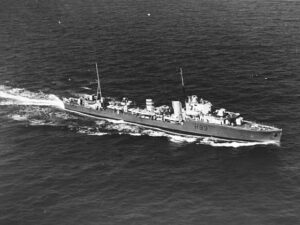 HMS Hereward was laid down at Vickers Armstrongs, Walker on 28 February 1935, launched on 10 March 1936 and completed on 9 December 1936.
HMS Hereward was laid down at Vickers Armstrongs, Walker on 28 February 1935, launched on 10 March 1936 and completed on 9 December 1936.
-Med Fleet, Spanish Civil War blockade mid-1937
-South Atlantic, hunting German commerce raiders/blockade runners, capturing one November 1939.
-Transferred to the Home Fleet May 1940, rescued Queen Wilhelmina after the invasion.
-Mediterranean Fleet, escorted convoys to Malta, sank a submarine (Dec) and TB Vega (Jan).
-Battle of Cape Matapan March 1941
-Evacuation of Allied troops from Greece, April 1941.
-May 1941 savaged a German convoy to Crete.
-Bombed and sunk by Sutaks during the evacuation of Allied troops from Crete, 28 May 1941.
-Crew rescued by Italian vessels, POWs until Sept. 1943.
 HMS Hero (H99)
HMS Hero (H99)
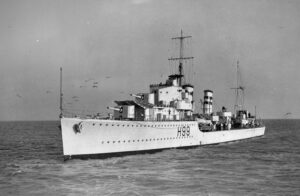 HMS Hero was laid down on 28 February 1935, launched 10 March 1936, completed on 21 October 1936. Note on the photo her interwar modified brigde (experimental) as completed.
HMS Hero was laid down on 28 February 1935, launched 10 March 1936, completed on 21 October 1936. Note on the photo her interwar modified brigde (experimental) as completed.
-Spanish Civil War 1936–1939, arms blockade (Mediterranean Fleet).
-Searched for German commerce raiders, South Atlantic
-April 1940 Second Battle of Narvik
-Mediterranean Fleet May 1940, escorted convoys to Malta.
-Battle of Cape Spada July 1940
-Operation Abstention February 1941
-Evacuations of Greece and Crete April–May 1941.
-Amphibious landings Syria–Lebanon Campaign June 1941
-Escorted convoys in June to Tobruk
-Damaged by Stukas while rescuing survivors from HMS Latona October 1941
-Second Battle of Sirte March 1942
-Operation Vigorous June 1942.
-Sank U-Boats U-568, U-559 Mediterranean 1942
-Converted to an escort destroyer, transferred RCN 1943, HMCS Chaudière.
-Mid-Ocean Escort Force 1944 Escort Group C2
-British coastal waters May-june, Operation Overlord.
-Sank U-744, U-621 and U-984
-In refit by May 1945, paid off August, sold for scrap 1946.
 HMS Hostile (H55)
HMS Hostile (H55)
 HMS Hostile was laid down at Scotts Shipbuilding & Engineering Co. in Greenock. She was laid down on 27 February 1935, launched on 24 January 1936 and completed on 10 September 1936.
HMS Hostile was laid down at Scotts Shipbuilding & Engineering Co. in Greenock. She was laid down on 27 February 1935, launched on 24 January 1936 and completed on 10 September 1936.
-Med Fleet, Spanish Civil War 1936–1939, arms blockade patrols
-Freetown (Sierra Leone) South Atlantiuc hunt for German Commerce Raiders from in October 1939
-First Battle of Narvik April 1940
-Battle of Calabria July 1940.
-Damaged by a mine off Cape Bon, Strait of Sicily 23 August 1940, crippled, scuttled by HMS Hero.
 HMS Hotspur (H01)
HMS Hotspur (H01)
 HMS Hotspur was laid down on 27 Feb. 1936, launched on 29 March 1936, completed on 29 December 1936.
HMS Hotspur was laid down on 27 Feb. 1936, launched on 29 March 1936, completed on 29 December 1936.
-Spanish Civil War 1936–1939, arms blockade patrols.
-First Battle of Narvik April 1940, badly damaged, repaired, to Gibraltar
-Battle of Dakar September 1940. October 1940 badly damaged when ramming (sinking) an Italian submarine.
-Battle of Cape Matapan March 1941
-Evacuated from Greece and Crete April–May 1941.
-June 1941 covered the Syria-Lebanon Campaign
-Escorted convoys and capital ships ships, Med Fleet
-Transferred to the Eastern Fleet, March 1942.
-Escorted HMS Illustrious for Operation Ironclad (invasion of Madagascar).
-June 1942 Operation Vigorous.
-Converted back home to escort destroyer 1943, North Atlantic
-Long refit late 1944, escorted convoys, Irish Sea until May 1945.
-TS postwar, reserve 1948.
-Sold to the Dominican Republic as Trujillo, then Duarte 1962, sold 1972.
 HMS Hunter (H35)
HMS Hunter (H35)
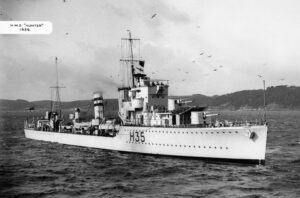 HMS Hunter was laid down at Swan Hunter, Wallsend on 27 March 1935. She was launched on 25 February 1936 and completed on 30 September 1936.
HMS Hunter was laid down at Swan Hunter, Wallsend on 27 March 1935. She was launched on 25 February 1936 and completed on 30 September 1936.
-Spanish Civil War 1936–1939, enforced the arms blockade, but struck a mine May 1937.
-Searched for German commerce raiders, South, Mid-Atlantic Ocean.
-Home waters February 1940.
-Norwegian Campaign: First Battle of Narvik, sunk by German destroyers on 10 April 1940.
 HMS Hyperion (H97)
HMS Hyperion (H97)
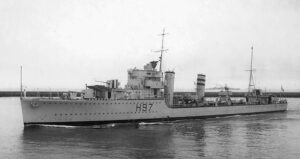 HMS Hyperion was laid down on 27 March 1935, launched 8 April 1936, completed on 3 December 1936.
HMS Hyperion was laid down on 27 March 1935, launched 8 April 1936, completed on 3 December 1936.
-Spanish Civil War 1936–1939, arms blockade
-Searched for German commerce raiders, South & Mid-Atlantic, blockaded German merchants in neutral harbours
-Norwegian Campaign, escorted ships, come out unscaved.
-Mediterranean Fleet: Battle of Calabria, Battle of Cape Spada July 1940
-Covered several convoys to Malta fall 1940
-Crippled by a mine, evacuated, scuttled on 22 December 1940.
Havant class (Brazilian order)
 HMS Harvester (H19, ex-Handy, ex-Jurua)
HMS Harvester (H19, ex-Handy, ex-Jurua)
 HMS Harvester was laid down as Jurua (former HMS Handy) Vickers Armstrongs, Barrow on 3 June 1938, launched on 29 September 1939 and completed on 23 May 1940.
HMS Harvester was laid down as Jurua (former HMS Handy) Vickers Armstrongs, Barrow on 3 June 1938, launched on 29 September 1939 and completed on 23 May 1940.
She was briefly trialled at Portland before assigned to the 9th DF. She took part in the Dunkirk evacuation on 29 May (272 evacuated to Dover) but was in distant cover on 30 May, making another evacuation on 30/31 May, diodging an U Boat attack and rescued 1341 men in two trips, 576 on 1 June. She took near misses by Stukas that day, repaired at Chatham. On 9 June she was sent to ecavuate troops at Le Havre, found none, but on the 11th she picked up 78 at Saint-Valery-en-Caux and escorted refugee and troop ships from Saint-Nazaire and St. Jean de Luz in Operation Aerial.
July-September saw her in convoy escort duties, Western Approaches Command (WAC). She rescued 90 from the AMC HMS Dunvegan Castle on 27 August. Next she was at Plymouth Command for anti-invasion duties 8-18 September and back to escort. On 30 October with Highlander, she sank U-32. On 5 Dec. she rescued 19 from Silverpine, 131 survivors from HMS Crispin on 3 February 1941, four from a RAF Whitley bomber on the 7th.
She had a refit at Barrow (18 March-18 April) and sent to Force H, Gibraltar for Operation Tiger and Splice in May. She was sent to the Newfoundland Escort Force in June, 14th Escort Group, St. John’s in July and then WAC in November, 9th Escort Group, converted to an escort destroyer at Dundee (30 January-16 April 1942) and retruned to the North Atlantic as flagship, Mid-Ocean Escort Force Escort Group B-3.
She was again refitted at Liverpool (12 December-11 February 1943). In the batte for Convoy HX 228 on 3 March she forced surfaced U-444 and rammed her but was badly damaged (propellers). She rescued five survivors from U-444. But on 11 March she was torpedoed by U-432, broke in half and sank with 9 officers and 136 ratings including the Escort Group leader AA “Harry” Tait. Aconit avenged her, sinking U-432 and rescued Harvester’s survivors.
 Havant (H32 ex-Javary)
Havant (H32 ex-Javary)
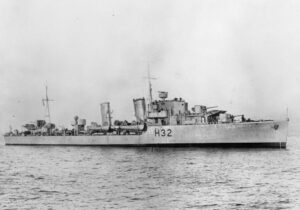 HMS Havant was laid down as Javary at J. Samuel White, Cowes on 30 March 1938, launched on 17 July 1939 and completed on 19 December 1939. She worked out at Portland Harbour on 8 January 1940 and was in ASW patrols from 4–9 February with Ardent and Whitshed, 9th DF WAC. She was refitted by March. After escorting a convoy to Greenock she went on to Gibraltar on 7 April, and transferred to the Home Fleet (Norway campaign), taking part in operations with Hesperus with the heavy cruiser Suffolk on 13 April, landing Royal Marines on the Faeroe Islands. She escorted convoys to Narvik until 7 May and later the ocean liners Lancastria and Franconia with troops on Iceland.
HMS Havant was laid down as Javary at J. Samuel White, Cowes on 30 March 1938, launched on 17 July 1939 and completed on 19 December 1939. She worked out at Portland Harbour on 8 January 1940 and was in ASW patrols from 4–9 February with Ardent and Whitshed, 9th DF WAC. She was refitted by March. After escorting a convoy to Greenock she went on to Gibraltar on 7 April, and transferred to the Home Fleet (Norway campaign), taking part in operations with Hesperus with the heavy cruiser Suffolk on 13 April, landing Royal Marines on the Faeroe Islands. She escorted convoys to Narvik until 7 May and later the ocean liners Lancastria and Franconia with troops on Iceland.
She took part in the Dunkirk evacuation from 29 May, rescued 2,300 men on 1 June alone. She took 500 from the disabled Ivanhoe by Stukas, and headed to Dover under heavy air attack. Before she made it, Stukas hit her with two bombs in her engine room and another underneath her her hull with 8 KiZ and 25 wounded plus at least 25 soldiers killed. Severely damaged she was evacuated and scuttled by the minesweeper HMS Saltash which was not powerful enough to tow her.
 Havelock (H88 ex-Jutahy)
Havelock (H88 ex-Jutahy)
 HMS Havelock was born as Jutahy on 31 May 1938 at J. Samuel White, launched on 16 October 1939 and completed on 10 February 1940. After trials and training she was assigned to the 9th DF, WAC. She was detached for the Norwegian Campaign (Allied landings 12–13 May Bjerkvik, Battle of Narvik). She provided fire support during the battle. On 30-31 May, she evacuated troops from from Bodø to Harstad and Borkenes and later troop ships from Narvik on 7-8 June under Capt. E. Barry Stevens, DSC. Back to the 9th DF she spent her lter years escorting convoys but was detached to Force H in Gibraltar for Operations Tiger, May 1941 and back to WAC. By March 1942 she was flotilla leader, Escort Group B-5, Mid-Ocean Escort Force until early 1944. 28 December-14 January 1943 saw the Convoy TM 1 battle for 9 oil tankers from Trinidad to Gibraltar against several wolfpacks, she could not protect seven fof these oilers but damaged U-436. She was also in the largest convoy, SC 122. By mid-1943 she was in the Bay of Biscay to hunt down U-boats, vectore din by the RAF. By September-October she escorted an airbase construction convoy to the Azores. In early 1944 she wa sin the 14th EG for Operation Overlord under cd. of Earl H. Thomas. With HMS Fame and Inconstant she sank U-767 on 18 June. She had a refit at Liverpool (July-September) and again in February–April 1945, completed by 30 April. With Hesperus she finished off U-246 at Anglesey. She later escorted surrendered German to Lough Foyle and on 27 May with Hesperus she carried back home the Norwegian government. Next she became an aircraft target and was in reserve from on 18 February 1946, sold for scrap 31 October.
HMS Havelock was born as Jutahy on 31 May 1938 at J. Samuel White, launched on 16 October 1939 and completed on 10 February 1940. After trials and training she was assigned to the 9th DF, WAC. She was detached for the Norwegian Campaign (Allied landings 12–13 May Bjerkvik, Battle of Narvik). She provided fire support during the battle. On 30-31 May, she evacuated troops from from Bodø to Harstad and Borkenes and later troop ships from Narvik on 7-8 June under Capt. E. Barry Stevens, DSC. Back to the 9th DF she spent her lter years escorting convoys but was detached to Force H in Gibraltar for Operations Tiger, May 1941 and back to WAC. By March 1942 she was flotilla leader, Escort Group B-5, Mid-Ocean Escort Force until early 1944. 28 December-14 January 1943 saw the Convoy TM 1 battle for 9 oil tankers from Trinidad to Gibraltar against several wolfpacks, she could not protect seven fof these oilers but damaged U-436. She was also in the largest convoy, SC 122. By mid-1943 she was in the Bay of Biscay to hunt down U-boats, vectore din by the RAF. By September-October she escorted an airbase construction convoy to the Azores. In early 1944 she wa sin the 14th EG for Operation Overlord under cd. of Earl H. Thomas. With HMS Fame and Inconstant she sank U-767 on 18 June. She had a refit at Liverpool (July-September) and again in February–April 1945, completed by 30 April. With Hesperus she finished off U-246 at Anglesey. She later escorted surrendered German to Lough Foyle and on 27 May with Hesperus she carried back home the Norwegian government. Next she became an aircraft target and was in reserve from on 18 February 1946, sold for scrap 31 October.
 HMS Hesperus (H57 ex-Hearty, ex-Juruena)
HMS Hesperus (H57 ex-Hearty, ex-Juruena)
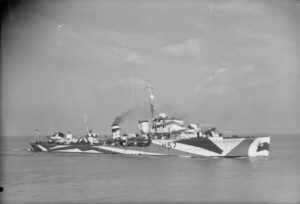 HMS Hesperus was born as HMS Hearty, then Juruena at John I. Thornycroft & Company in Woolston on 6 July 1938. She was launched on 1 August 1939 and completed on 22 January 1940. She joined the 9th DF, Home Fleet for ASW of Scapa Flow. With the occupation of Denmark, she covered the British occupation of the Faroe Islands in April. She took part in the Norwegian Campaign, carrting Scots Guards to Mo i Rana on 15 May 1940, near missed by Stukas. She was repaird in Dundee for a month.
HMS Hesperus was born as HMS Hearty, then Juruena at John I. Thornycroft & Company in Woolston on 6 July 1938. She was launched on 1 August 1939 and completed on 22 January 1940. She joined the 9th DF, Home Fleet for ASW of Scapa Flow. With the occupation of Denmark, she covered the British occupation of the Faroe Islands in April. She took part in the Norwegian Campaign, carrting Scots Guards to Mo i Rana on 15 May 1940, near missed by Stukas. She was repaird in Dundee for a month.
The 9th DF was transferred to WAC as the 9th Escort Group and on 4 November Hesperus rescued 367 from HMS Laurentic.
She was damaged by a tropical storm in January 1941 (‘B’ gun detached) and after repairs was detached to Force H, Gibraltar, for Operations Tiger and Tracer by May-June and returned to the WAC, had a brief refit in Liverpool and ended in the Newfoundland Escort Force on 7 July.
In August 1941, she escorted HMS Prince of Wales to the Atlantic Charter meeting, Placentia Bay, being damaged by heavy weather, repaired in Iceland and later at Immingham. She wa slater detached again to Force H in December 1941. With Harvester she sank U-208 on 7 December west of Gibraltar. On 15 January 1942 with Convoy HG 78 she detected U-93 and commander A. A. Tait, ordered to ram her while surfaced. The glancing hit, still destroyed her conning tower and she dropped dropping depth charges at their shallowest setting while pummling her with 4.7-inch shells untuil the crew abandoned her. She rescued 40. She needed repairs, having the forward hull muched, buckled starboard and starboard propeller. After Gibraltar he was repaored in Falmouth in February-April. By March 1942 she was in Escort Groups B-1 and B-5. under command of A.F.St.G. Orpen in B-2 EG from April and later her first commander Macintyre returned. During Convoy HX 219 near Rockall on 26 December with Vanessa she sank U-357 by ramming. This cost her dearly with her bottom ripped open: Three months repairs in Liverpool.
Back on 17 March, she sank on the 23th april U-191 with her Hedgehog with Convoy ONS 4. On 12 May she sank U-186 with convoy SC 129. She was refitted in January-late March 1944 and G.V. Legassick took command. She escorted convoys to and from Gibraltar. By July 1944 she conveyed the body of Captain Frederic John Walker for a sea-burial. Back to the 19th EG in January 1945 under Cdr R.A. Currie she took the head of the 14th EG in Plymouth. On 30 April with Havelock, she finished off U-246 off Anglesey. With the 14th EG she escorted surrendered U-boats from Loch Alsh. On 27 May with Havelock she carried back home the Norwegian government. She later served as aircraft target, in reserve from 18 February 1946, sold for BU and towed on 17 May 1947.
 HMS Highlander (H44 ex-Jaguaribe)
HMS Highlander (H44 ex-Jaguaribe)

HMS Highlander was laid down as Jaguaribe on 28 September 1938 at John I. Thornycroft, launched on 19 October 1939 and completed on 18 March 1940. After working up at Portland she joined the 9th DF, Home Fleet in escort from 11 April. On the 17th she ran aground in the Shetlandsn but damage was limited. She was re-floated, repaired at Hull (20 April-19 May) and later escorted HMS Renown to Scapa Flow on 24 May. In WAC by mid-June she rescued survivors from Scotstoun. Later she took part in Operation Aerial evacuations.
Back to the 9th DF until January 1941 she cmaimed U-32 on 30 October. On 1 December she escorted HMCS Saguenay to Barrow-in-Furness for repairs. She was refitted at Hawthorn Leslie’s, Hebburn (30 January-23 March 1941) and detached to Force H, Gibraltar, convoys to Freetown in escort duties, 18th DF until August and the back to Londonderry, 28th EG, WAC.
She was refitted from 2 February to –18 March 1942 at Tilbury and became flotilla leader, EG B4, Mid-Ocean Escort Force, Convoy SC 122 (largest convoy battle of the war, March 1943), dodging torpedoes by U-441 and U-608. She was overhauled at Troon (28 December–12 April 1944) and collided with a tugboat. She remained in her group until September, transferred to EG B2 as flotilla leader. On 15 April 1945 she hit an iceberg that mushed her bow, towed to Bay Bulls in Newfoundland, for repairs completed at St. John’s until 24 July 1944. Back in Rosyth she became a target ship for the RAF ended later in Category C reserve (19 January 1946) sold 27 May 1947.
 HMS Hurricane (H66 ex-Japura)
HMS Hurricane (H66 ex-Japura)

HMS Hurricane was laid down as Japura at Vickers Armstrongs, Barrow on 3 June 1938. She was launched on 29 September 1939 and completed on 21 June 1940.
She was assigned to the 9th DF, Home Fleet, escorting convoys until May 1941. On 17 September she rescued survivors of City of Benares, underway to Canada, and the freighter Marina, then 451 survivors from City of Nagpur in late April 1941. Her career was nearly ended as she was bombed and sunk in a German air raid on Liverpool on 7/8 May 1941. A bomb passed through her hull detonating underneath creating a pool-like hole in which flooding was unstoppable and brutal. Soon her engine room and oil tanks were entirely underwater, her structure badly damaged and she was about to lost her stern, sag downwards. She was towed with cauution to Bidston Dock to avoid blocking traffic in the harbour. The mircle was she only had a few crewmen injuried as her crew was on leave that day.
Yet despite the immense damage, she was fully repaired and returned to service in January 1942, as flotilla leader, Escort Group B1, Mid-Ocean Escort Force, for the next two years. Her most serious close call was while in Convoy OS 62/KMS 36, when hit by an acoustic T5 torpedo fired by U-415 on 24 December 1943. Homing in by her propeller noises it blew off 30 feet (9.1 m) of her stern, killed 3, wounding 9 of her crew, and she became a sitting duck. Too damaged to be towed and still flooding, she was scuttled by HMS Watchman on Xmas day 1943.
Read More/Src
Books
Cocker, Maurice Destroyers of the Royal Navy, 1893-1981, 1983, Ian Allan
Dickens, Peter (1972). HMS Hesperus. Windsor, UK: Profile Publications.
Conway’s All the World’s Fighting Ships, 1922-1946, Ed. Robert Gardiner, Naval Institute Press
M. J. Whitley Destroyers of World War II, An International Encyclopedia, Arms and Armour Press, 1988
Barnett, Correlli (1991). Engage the Enemy More Closely: The Royal Navy in the Second World War. New York: Norton.
Cain, T. J.; Sellwood, A. V. (1976). H.M.S. ‘Electra’. London: Futura Publications.
Colledge, J. J.; Warlow, Ben (2006) [1969]. Ships of the Royal Navy: The Complete Record of all Fighting Ships of the Royal Navy (Rev. ed.). Chatham Publishing.
English, John (1993). Amazon to Ivanhoe: British Standard Destroyers of the 1930s. Kendal, England: World Ship Society.
Friedman, Norman (2006). British Destroyers & Frigates: The Second World War and After. Annapolis, Maryland: Naval Institute Press.
Lenton, H. T. (1998). British & Empire Warships of the Second World War. Annapolis, Maryland: Naval Institute Press.
Rohwer, Jürgen (2005). Chronology of the War at Sea 1939–1945: The Naval History of World War Two (Third Revised ed.). NIP
Van der Vat, Dan The Atlantic Campaign: World War II’s Great Struggle at Sea (Harper and Row, New York, 1988).
Links
on navypedia.org
on dreadnoughtproject.org/
uboat.net/ H class
uboat.net/ G class
en.wikipedia.org
on commons.wikimedia.org
worldnavalships.com
battleships-cruisers.co.uk/
Video
Model Kits
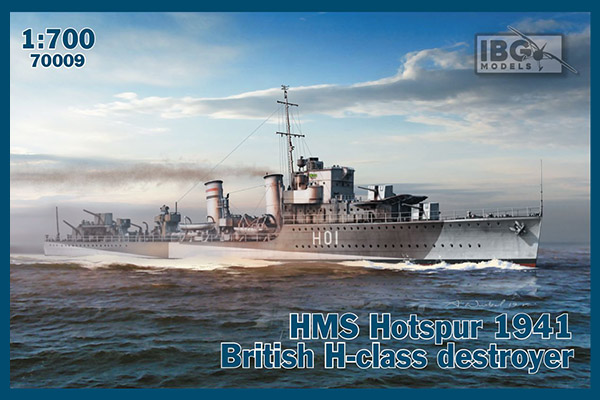
scalemates: Parts Buenos Aires and Vasilefs Giorgios class
G-H class on scalemates.com all kits

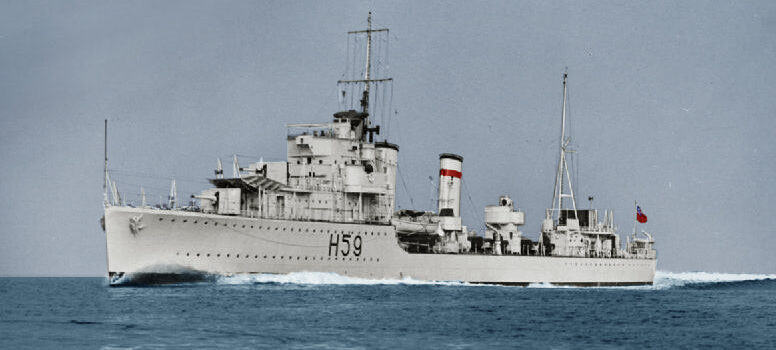
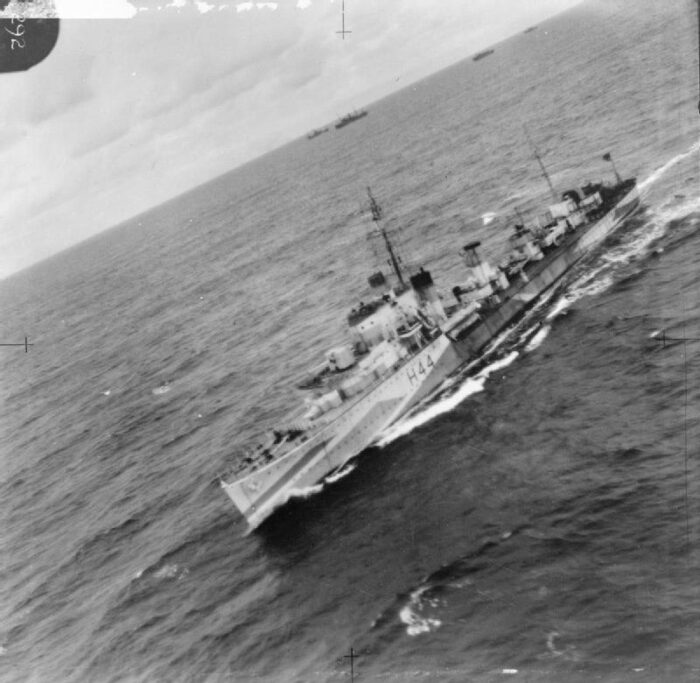
 Latest Facebook Entry -
Latest Facebook Entry -  X(Tweeter) Naval Encyclopedia's deck archive
X(Tweeter) Naval Encyclopedia's deck archive Instagram (@navalencyc)
Instagram (@navalencyc)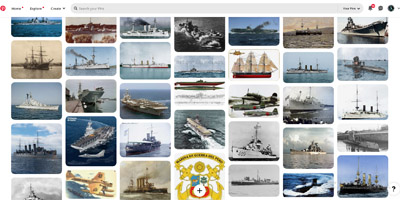

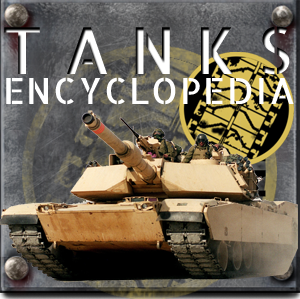
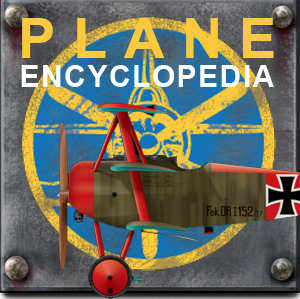
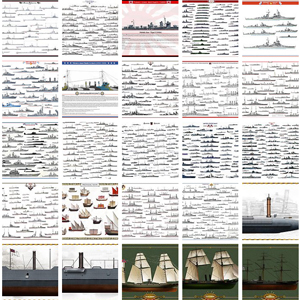
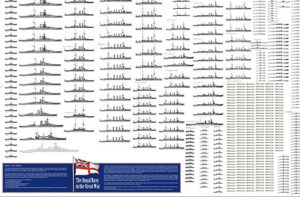
 French Navy
French Navy Royal Navy
Royal Navy Russian Navy
Russian Navy Armada Espanola
Armada Espanola Austrian Navy
Austrian Navy K.u.K. Kriegsmarine
K.u.K. Kriegsmarine Dansk Marine
Dansk Marine Nautiko Hellenon
Nautiko Hellenon Koninklije Marine 1870
Koninklije Marine 1870 Marinha do Brasil
Marinha do Brasil Osmanlı Donanması
Osmanlı Donanması Marina Do Peru
Marina Do Peru Marinha do Portugal
Marinha do Portugal Regia Marina 1870
Regia Marina 1870 Nihhon Kaigun 1870
Nihhon Kaigun 1870 Preußische Marine 1870
Preußische Marine 1870 Russkiy Flot 1870
Russkiy Flot 1870 Svenska marinen
Svenska marinen Søværnet
Søværnet Union Navy
Union Navy Confederate Navy
Confederate Navy Armada de Argentina
Armada de Argentina Imperial Chinese Navy
Imperial Chinese Navy Marinha do Portugal
Marinha do Portugal Mexico
Mexico Kaiserliche Marine
Kaiserliche Marine 1898 US Navy
1898 US Navy Sovietskiy Flot
Sovietskiy Flot Royal Canadian Navy
Royal Canadian Navy Royal Australian Navy
Royal Australian Navy RNZN Fleet
RNZN Fleet Chinese Navy 1937
Chinese Navy 1937 Kriegsmarine
Kriegsmarine Chilean Navy
Chilean Navy Danish Navy
Danish Navy Finnish Navy
Finnish Navy Hellenic Navy
Hellenic Navy Polish Navy
Polish Navy Romanian Navy
Romanian Navy Turkish Navy
Turkish Navy Royal Yugoslav Navy
Royal Yugoslav Navy Royal Thai Navy
Royal Thai Navy Minor Navies
Minor Navies Albania
Albania Austria
Austria Belgium
Belgium Columbia
Columbia Costa Rica
Costa Rica Cuba
Cuba Czechoslovakia
Czechoslovakia Dominican Republic
Dominican Republic Haiti
Haiti Hungary
Hungary Honduras
Honduras Estonia
Estonia Iceland
Iceland Eire
Eire Equador
Equador Iran
Iran Iraq
Iraq Latvia
Latvia Liberia
Liberia Lithuania
Lithuania Mandchukuo
Mandchukuo Morocco
Morocco Nicaragua
Nicaragua Persia
Persia San Salvador
San Salvador Sarawak
Sarawak Uruguay
Uruguay Venezuela
Venezuela Zanzibar
Zanzibar Warsaw Pact Navies
Warsaw Pact Navies Bulgaria
Bulgaria Hungary
Hungary

 Bundesmarine
Bundesmarine Dutch Navy
Dutch Navy Hellenic Navy
Hellenic Navy Marina Militare
Marina Militare Yugoslav Navy
Yugoslav Navy Chinese Navy
Chinese Navy Indian Navy
Indian Navy Indonesian Navy
Indonesian Navy JMSDF
JMSDF North Korean Navy
North Korean Navy Pakistani Navy
Pakistani Navy Philippines Navy
Philippines Navy ROKN
ROKN Rep. of Singapore Navy
Rep. of Singapore Navy Taiwanese Navy
Taiwanese Navy IDF Navy
IDF Navy Saudi Navy
Saudi Navy Royal New Zealand Navy
Royal New Zealand Navy Egyptian Navy
Egyptian Navy South African Navy
South African Navy






























 Ukrainian Navy
Ukrainian Navy dbodesign
dbodesign